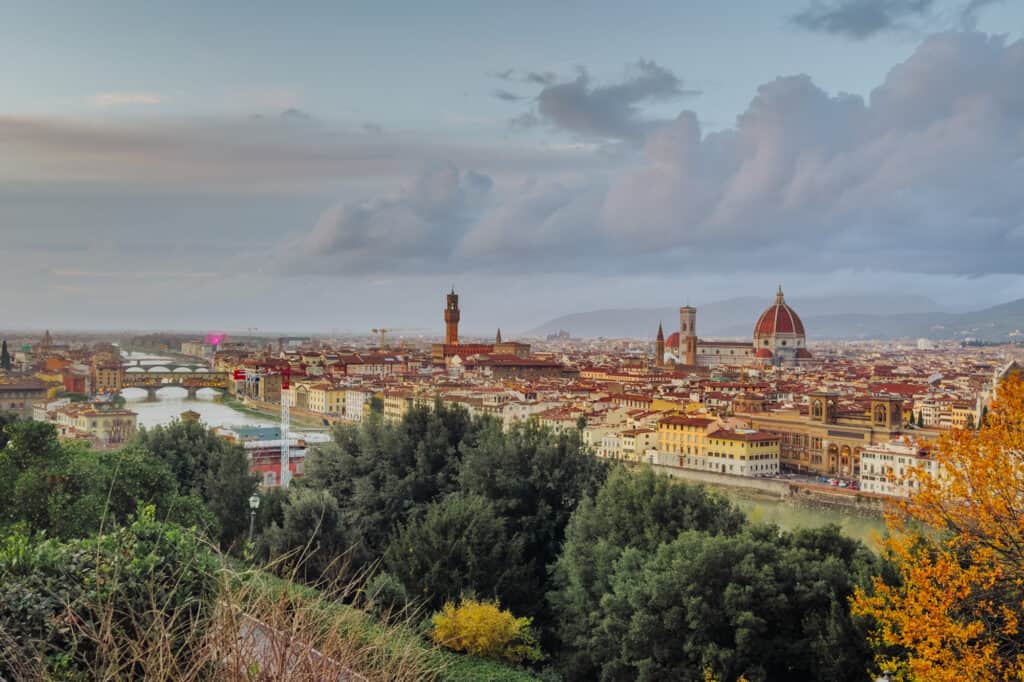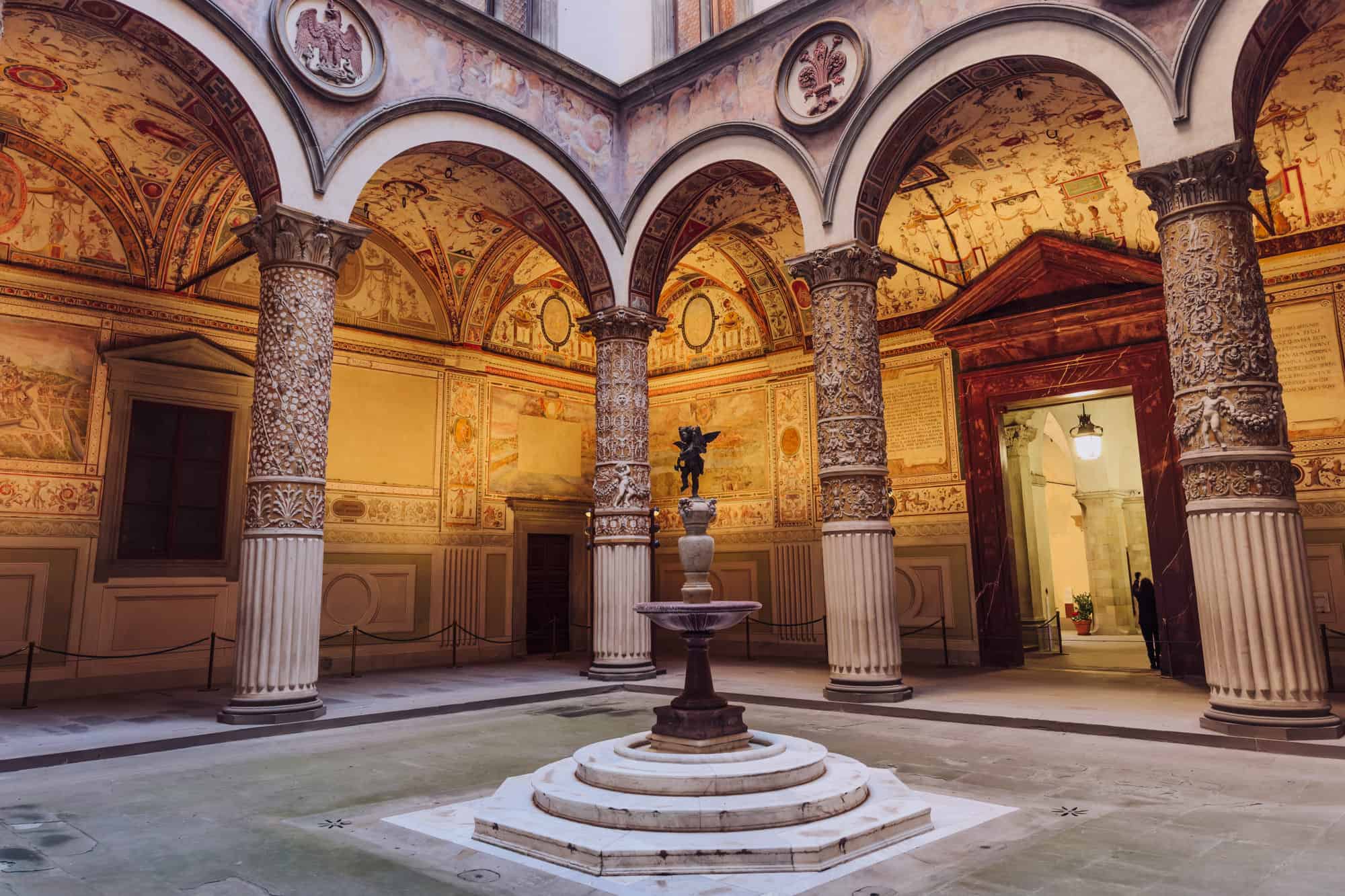A Guide to 3 Days in Florence, Italy

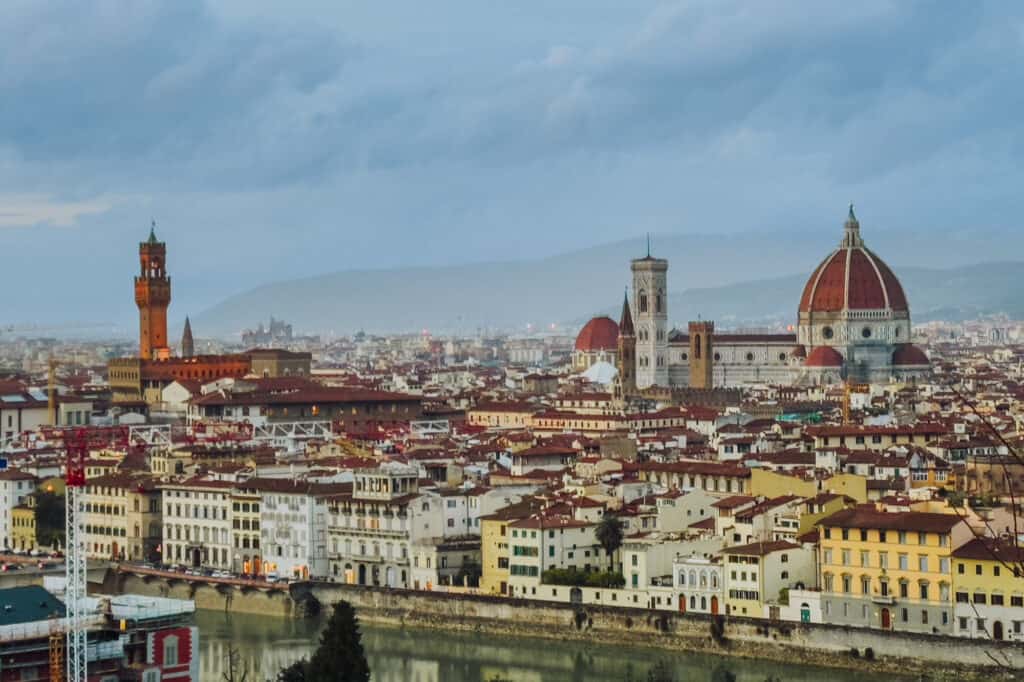
You can experience an amazing blend of art, history, culture, and culinary experiences over 3 days in Florence, Italy!
As the “birthplace of the Renaissance,” and home to Michelangelo and da Vinci, Florence is essentially an open-air museum, showcasing the most famous works of art in the world.
Add to that, Florence’s history as a center of trade and culture during the Renaissance, and the intricate facades of cathedrals and palazzos.
While Florence isn’t known for its seafood, the pasta, meats, and wines will create a gastronomic journey for any fine-paletted foodie (or amateur, like myself!).
Florence is also a haven for shoppers, who could spend 3 days just strolling the cobblestone streets for Italian leather goods.
This 3-day itinerary is for people who want to experience Florence, and also the surrounding smaller towns, rolling hills, and vineyards in Tuscany, Italy.
The Best Tours in Florence
Over 3 days in Florence, you can choose to be your own guide, or take a tour with a historian or local expert.
These are the top 3 tours I’d recommend for famous sites in the city, and great road trips in Tuscany:
➡️ Book: The Duomo, David, & More: Skip the Line Tour
Where to Stay in Florence on a 3-Day Trip
Florence is a walkable city, which is relatively small. As long as you’re staying between the main train station (Firenze Santa Maria Novella) and the river, you’ll be in a great location. Even the other side of the Arno River has great rental and hotel options.
If you’re looking to do day trips using the excellent train system, I’d recommend staying on the north side of the river, just for convenience.
You can use this interactive map to plug in your dates and see the rates available for your visit. It includes the top hotel sites, like Booking.com and VRBO:
Florence Walking Tour Map
The map below lays out an ambitious day in Florence, which will take you to the most famous sites in the city.
The entire route is between 3 and 4 miles, and is largely flat, aside from the climb to the overlook at Piazzale Michelangelo.
Of course, you can choose to go in any order, and omit whichever stops you’d like.
If you’re not an art lover, you can follow this walking tour to see all of the most famous buildings and views in Florence! For people who fall into that category, you’ll still see plenty of statues and artwork just walking around.
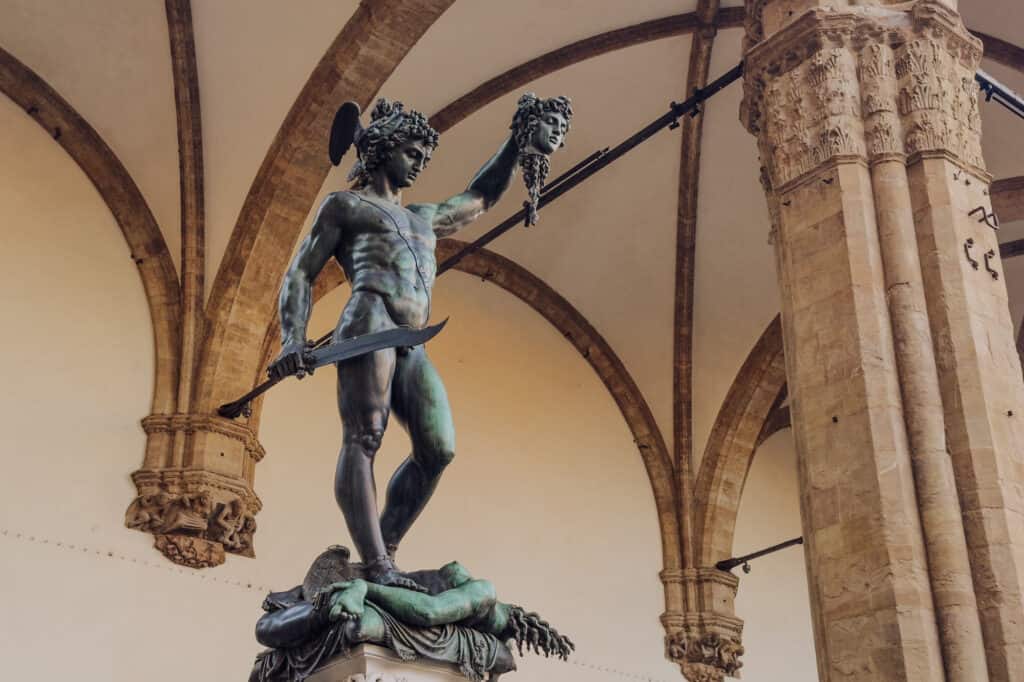
3 Days in Florence: Day 1: The City
Let’s go a bit more into detail about the sites mapped above.
These are brief descriptions. You can read more about the history of each down below in this post.
Florence Cathedral (Duomo)
Start your day with a visit to the Duomo, Florence’s Cathedral. Marvel at its stunning architecture, including the red-tiled dome by Brunelleschi, Giotto’s Bell Tower, and the Baptistery’s famed bronze doors.
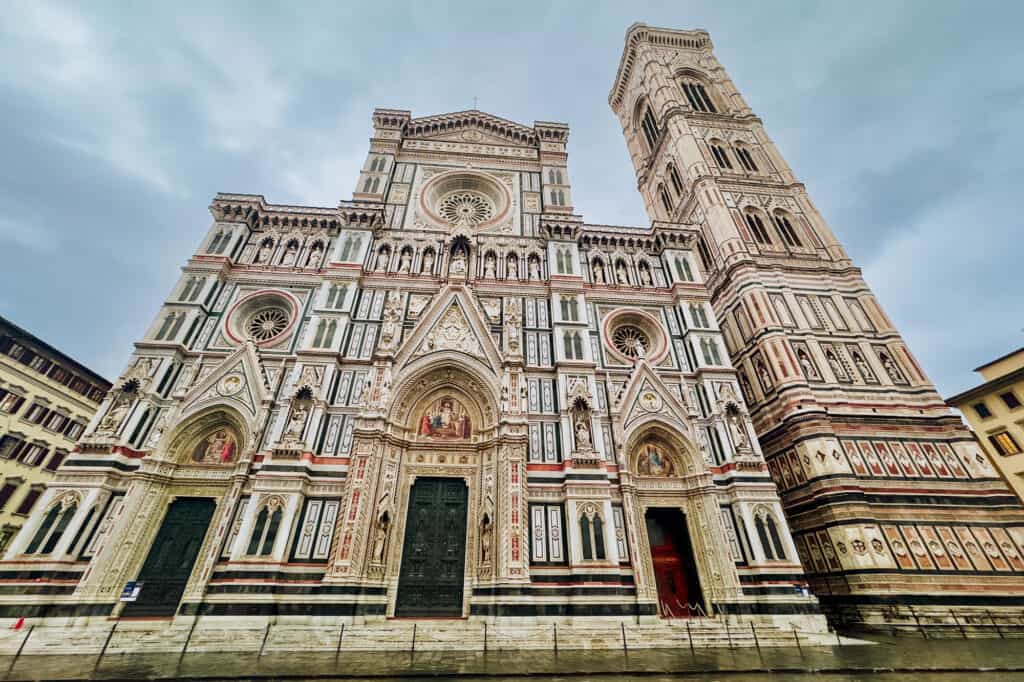
Piazza della Signoria
Wander through this historic square, surrounded by impressive sculptures and the Palazzo Vecchio, Florence’s town hall. Admire the open-air museum of statues, including a replica of Michelangelo’s David, and soak in the vibrant atmosphere.
Uffizi Gallery
Explore one of the world’s most renowned art museums, the Uffizi Gallery. Home to an impressive collection of Renaissance masterpieces, including works by Botticelli, Leonardo da Vinci, Michelangelo, and Raphael, among others.
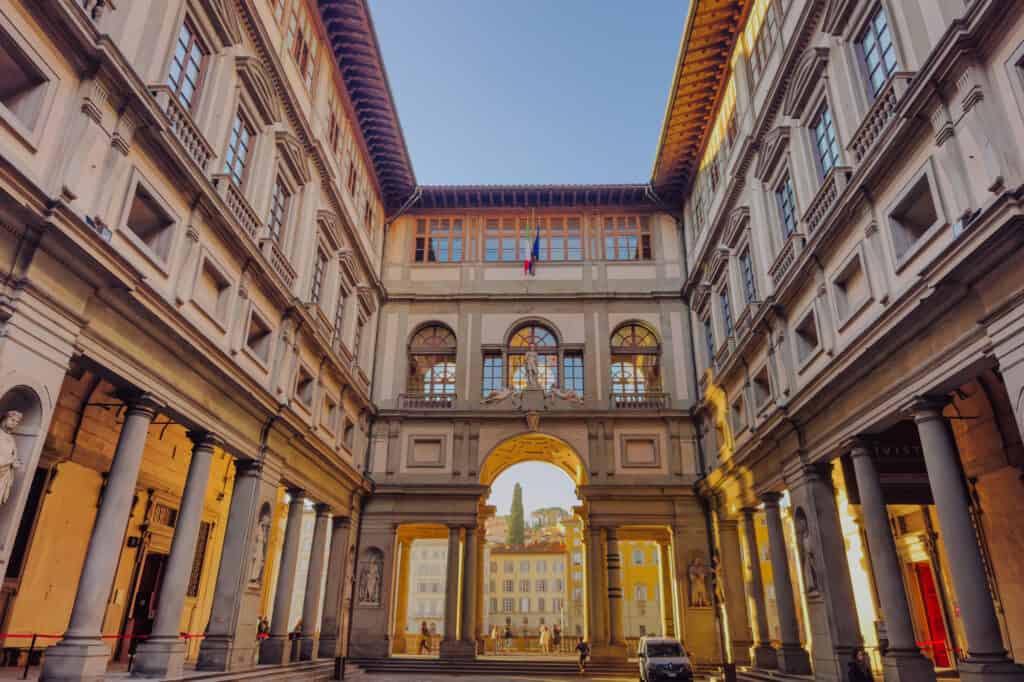
Ponte Vecchio
Stroll to the picturesque Ponte Vecchio, a medieval bridge spanning the Arno River. It’s largely a covered bridge, filled with jewelry shops.
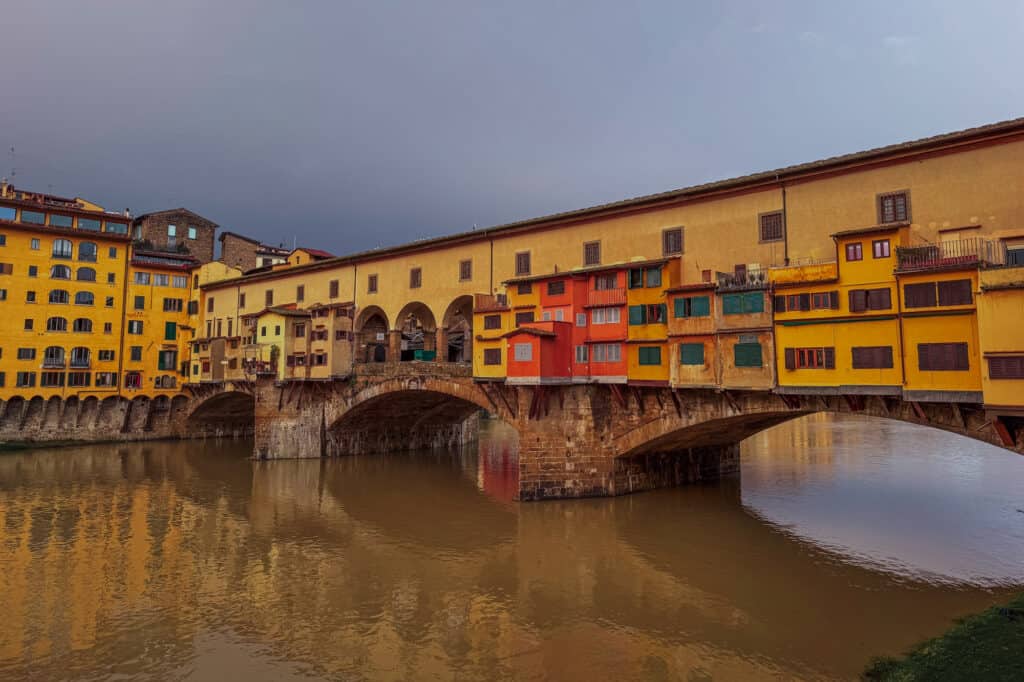
FOOD TIP: Stop at Gino’s across the bridge for a delicious Italian pastry and coffee!
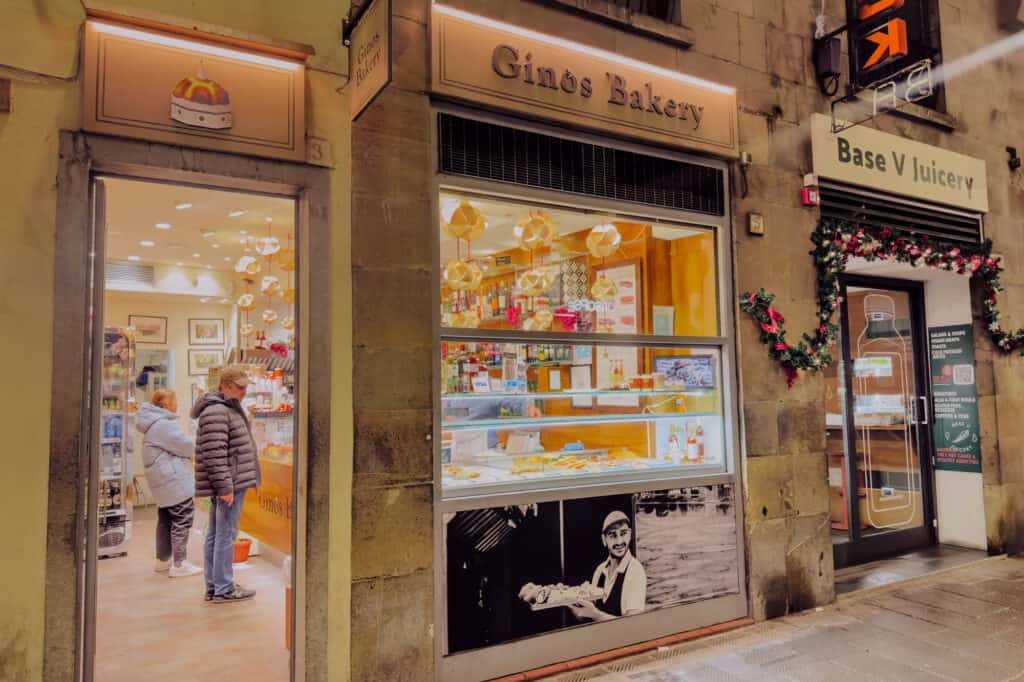
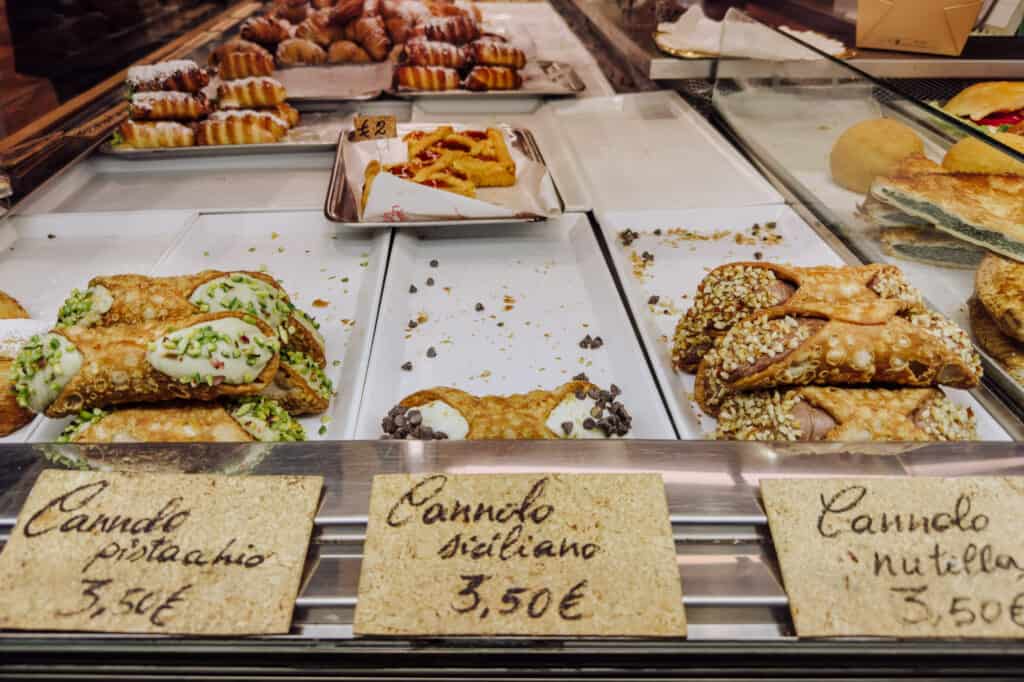
Palazzo Pitti and Boboli Gardens
Across the Ponte Vecchio, you’ll reach the Palazzo Pitti, a Renaissance palace with a vast art collection. Then, take a leisurely stroll through the Boboli Gardens behind the palace, featuring beautiful landscapes, fountains, and sculptures.
The Best View in Florence: Piazzale Michelangelo
It’s a hike (or a taxi ride) up to Piazzale Michelangelo, but it’s worth the walk for the stunning view!
Consider stopping here for sunset on your first day. It’ll give you an appreciation for the beauty and the layout of the city of Florence.
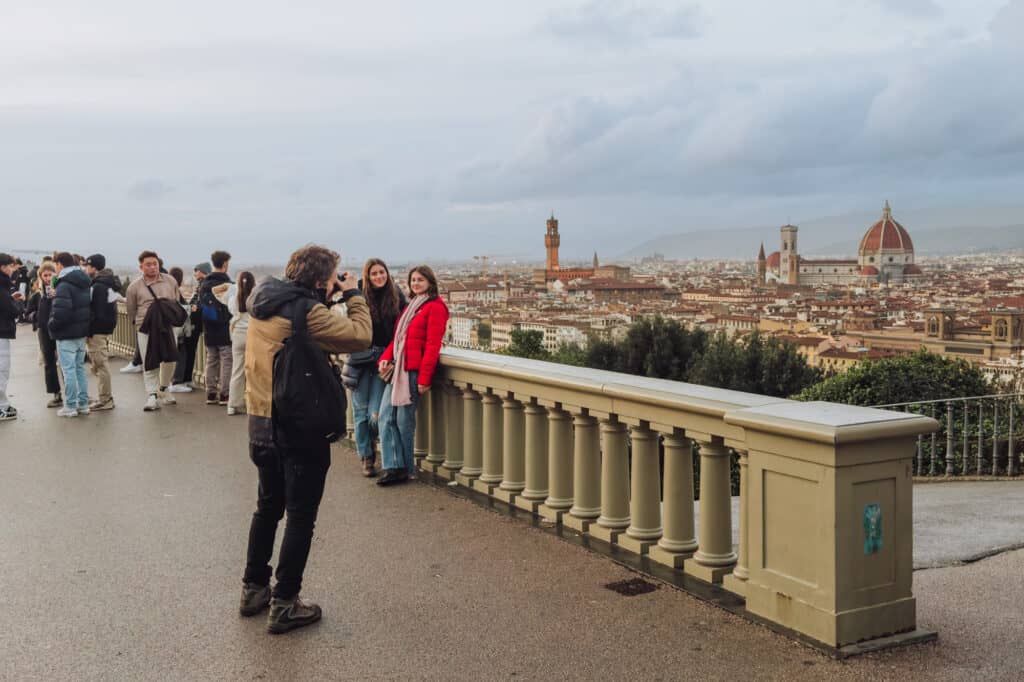
Plus, if you’ve skipped seeing the original “David,” there’s a bronze replica here in the plaza to check out.
Basilica of Santa Croce
This Franciscan church is known for its beautiful frescoes, and as the burial site of Michelangelo, Galileo, and Machiavelli.
There are often markets in the plaza in front of the cathedral.
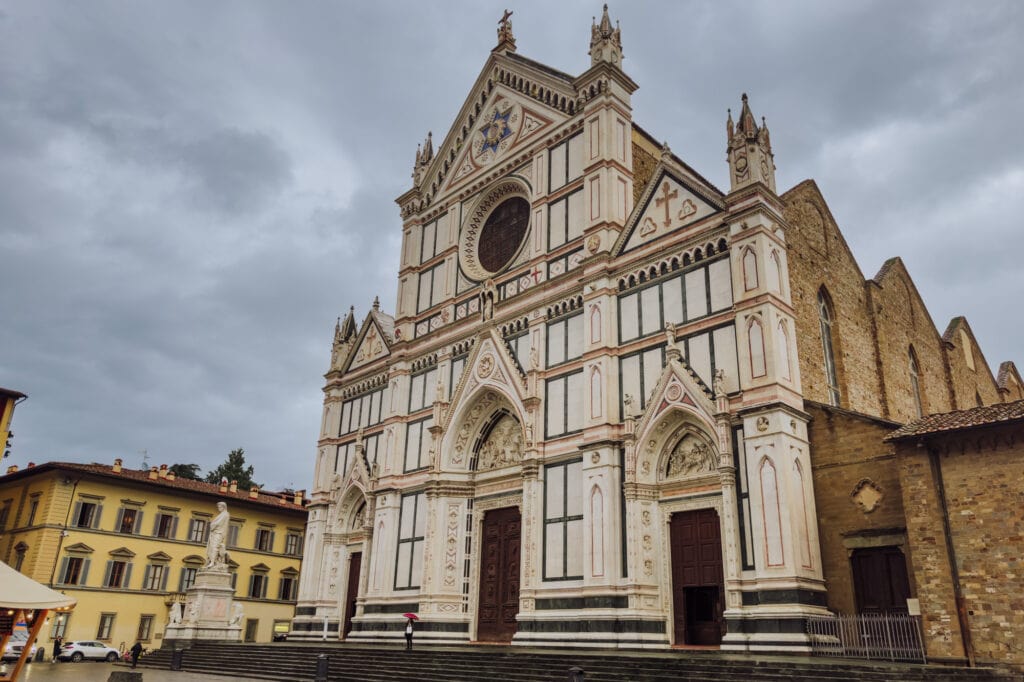
3 Days in Florence: Day 2: Tuscany Road Trip
As the capital of the Tuscany region, Florence serves as an excellent base for exploring the picturesque Tuscan countryside, dotted with vineyards, rolling hills, and charming towns like San Gimignano, Siena, Pisa, and Lucca.
Tuscany Road Trip Tours
These are three day trip tours I’d take through Tuscany from Florence. Each has excellent reviews:
➡️ Book: Florence to Pisa, Siena, and San Gimignano
Renting and Driving Yourself
Driving in Florence is easy, and there are convenient car rental options at the airport or just outside the train station. Personally, I’d choose to rent from the area around the Firenze Santa Maria Novella train station.
Usually in Europe, I use Discover Cars. They provide the big international rental brand options, along with very good local rental companies.
Map of Day Trip Destinations from Florence
You can see on the map how close these smaller cities and towns are to Florence:
This itinerary makes for a great road trip on day 2 of your 3 days in Florence:
Morning:
- Start from Florence: Depart early to make the most of your day. Tuscany’s roads wind through beautiful countryside, so driving allows you to savor the scenery.
- Drive to San Gimignano: The drive to San Gimignano takes around an hour, depending on the route you take. Enjoy the scenic roads flanked by vineyards, rolling hills, and cypress trees.
Mid-Day:
- Explore San Gimignano: Arrive at San Gimignano, known for its medieval towers that dominate the skyline. Wander through the charming streets, visit the Piazza della Cisterna, and climb one of the towers for panoramic views of the Tuscan countryside.
- Lunch: Enjoy lunch at one of the local trattorias or restaurants, sampling traditional Tuscan cuisine. Sample the local Vernaccia wine, famous in this region.
Afternoon:
- Scenic Drive: After exploring San Gimignano, consider a drive through the countryside, through the olive groves and vineyards to other nearby towns like Volterra.
- Siena: By car, Siena is less than an hour from San Gimignano. Head to Piazza del Campo, surrounded by historic buildings and medieval architecture. The city center is a UNESCO World Heritage Site. Step inside the Siena Cathedral, famous for its intricate marble work and frescoes.
Look for roadside stands or local markets for fresh produce, olive oil, or wine to take back as souvenirs.
Day 2 Alternate: By Train
You could easily take the train from the Santa Maria Novella Station in Florence to Siena. It’s about a 90-minute ride each way on the Trenitalia line.
I’ve been using Trainline to book trains in Europe. It’s simple to search, and avoids the kiosks in the train stations. They send you a QR code to your text and email, which you have scanned at the station to board.
➡️ Click to Book Train Tickets in Italy
I’d recommend San Gimignano, if you’ve never been to the area. It’s crowded in the summer, but you’ll understand why it’s such a favorite among tourists!
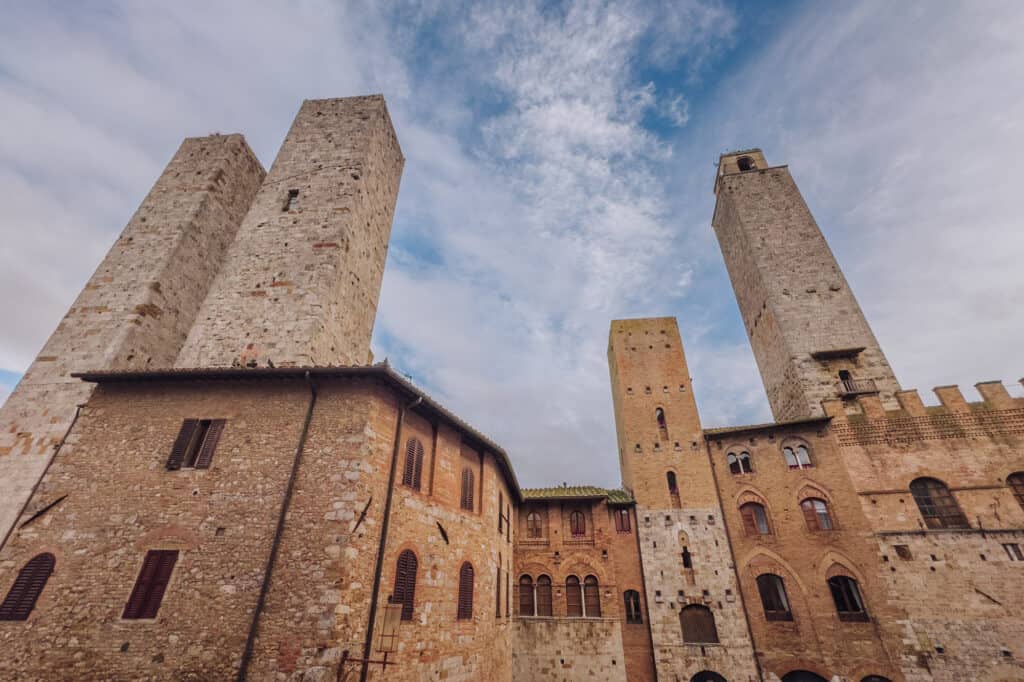
Florence to San Gimignano by Train
From Santa Maria Novella in Florence, you’ll take the train to Poggibonsi. It’ll be about 9 Euros each way.
The train usually leaves once an hour from Florence.
In Poggibonsi, you can walk outside the train station and take Bus #130 up the hill to San Gimignano.
It’s a 25-minute bus ride.
Alternatively, you can look for a taxi outside the train station. The general going rate for a ride from Poggibonsi to San Gimignano is 35 Euros.
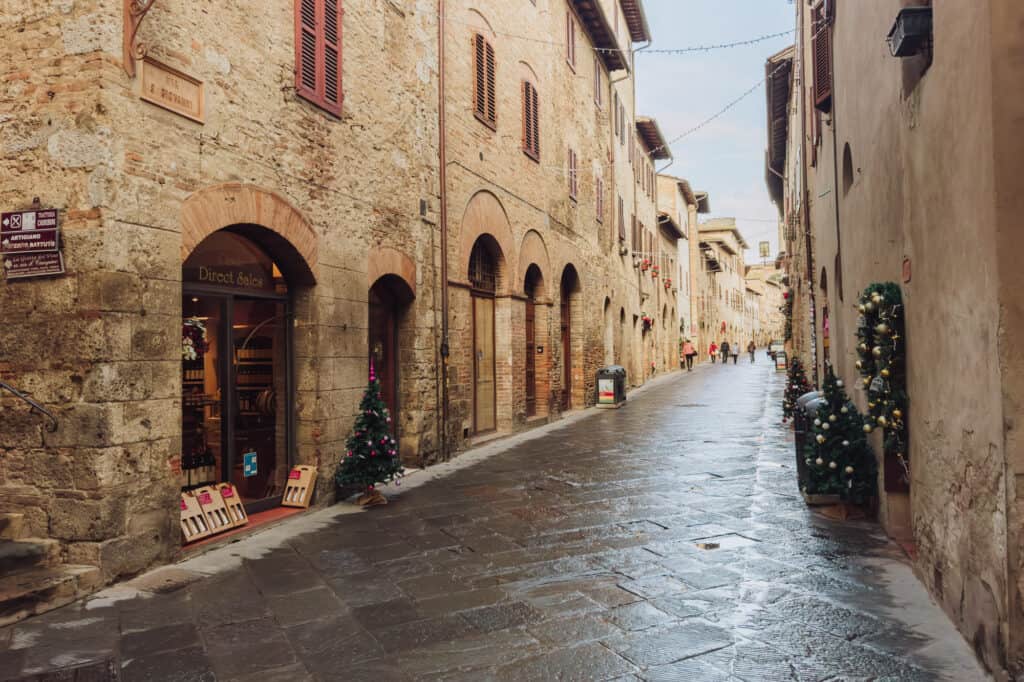
San Gimignano to Florence
You might find a taxi at the gates of San Gimignano. If a driver isn’t waiting, you can buy a bus ticket at the Tabacchi store on the main street in town. It’ll be 3 Euros for the ride back down to Poggibonsi.
Buses can be intimidating in foreign countries, but I promise: this one’s pretty easy to navigate!
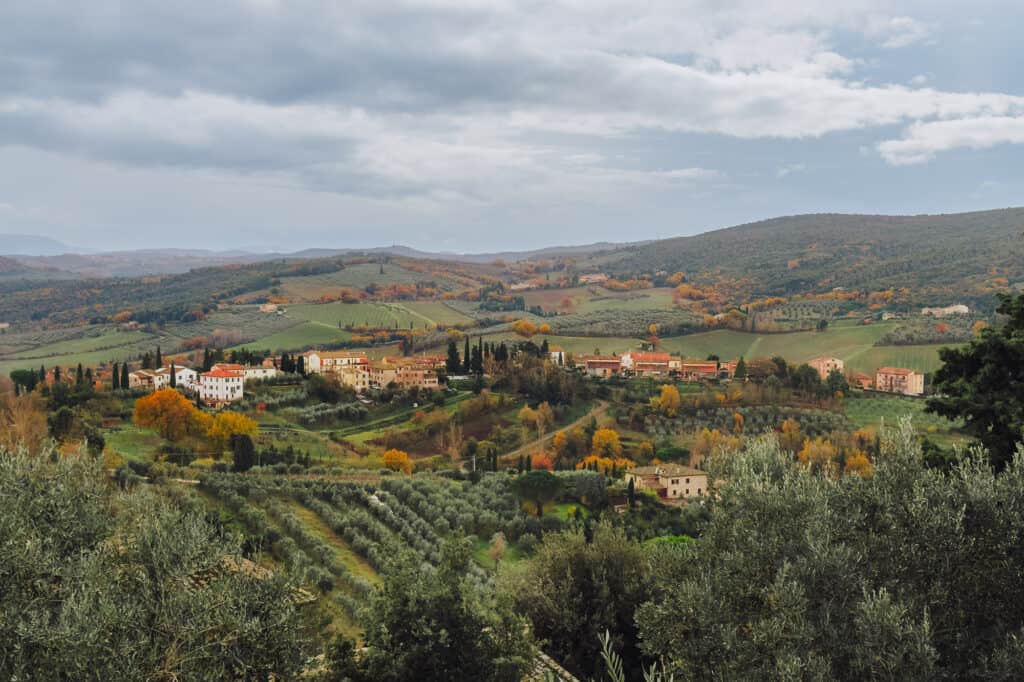
3 Days in Florence: Day 3: Pisa & Lucca Road Trip
You can easily take the train, take a tour, or drive yourself to Pisa and Lucca for a day trip on day 3 of your time in Florence.
Pisa Tour from Florence
This is a PRIVATE tour option I’d choose from Florence to Pisa and Lucca, with excellent reviews:
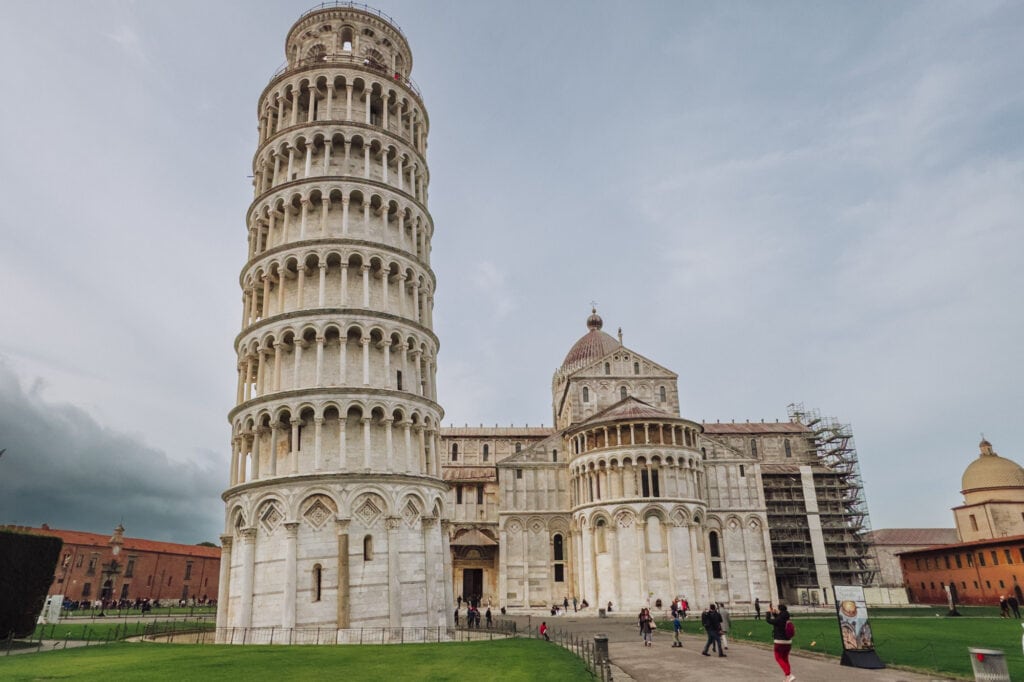
Rent and Drive Yourself
The drive to Pisa is a little over an hour from Florence.
While the city has its own rich culture, if you only have 3 days in Florence, you can “see” Pisa in a morning.
Morning:
- Depart from Florence: Start your road trip early to make the most of your day.
- Visit the Leaning Tower: Upon arrival in Pisa, head straight to Piazza dei Miracoli (Square of Miracles), where you’ll find the Leaning Tower of Pisa, the Cathedral (Duomo), and the Baptistery. If you’re going during a busy season and want to climb the tower, buy advanced tickets.
- Mid-Day: Wander through the charming streets of Pisa adjacent to the Piazza dei Miracoli, and stop in at one of the cafes for lunch.
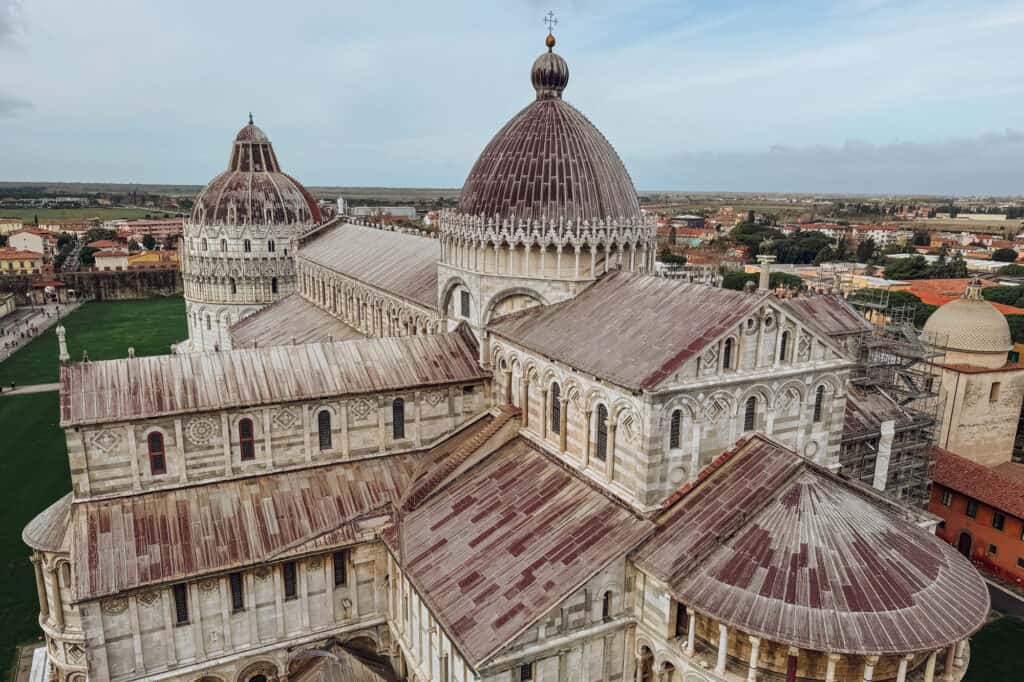
Afternoon:
- Drive to Lucca: Lucca is only 45 minutes from Pisa. You’ll find massive Renaissance walls encircling the city, and can rent bicycles and cycle along the top of the walls for panoramic views.
- Visit Lucca’s Highlights: Explore the historic center, visit the Cathedral of St. Martin (Duomo di San Martino), climb the Guinigi Tower for a view of the city, and wander through the picturesque streets lined with charming shops and cafes.
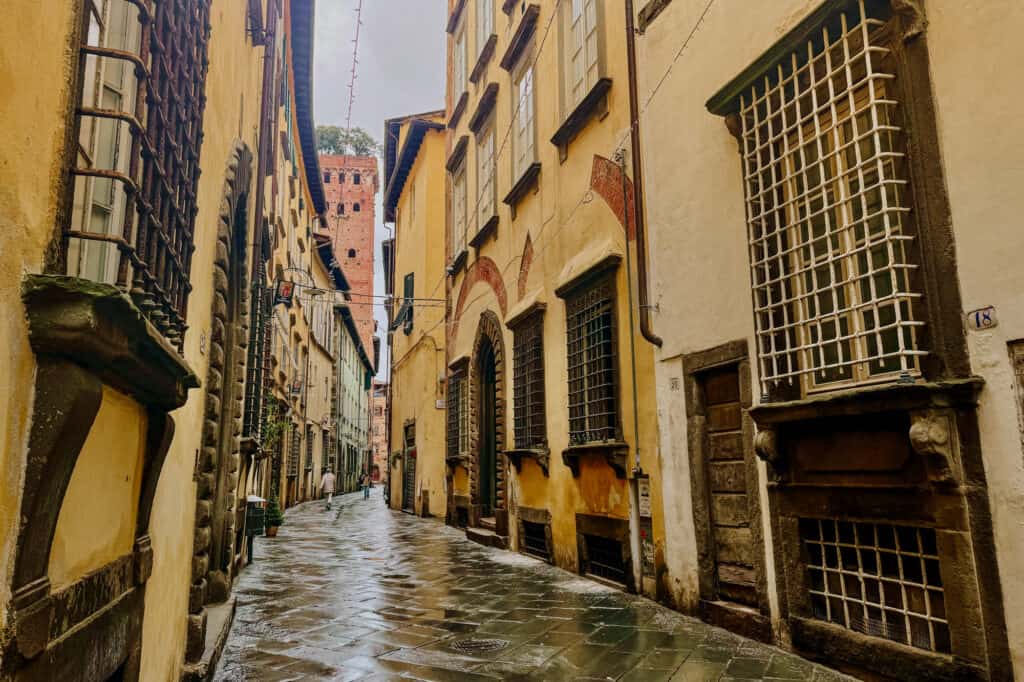
Day 3 Alternate: By Train
This is another day trip from Florence which is easily accomplished by train.
Florence to Pisa by Train
From Florence’s Santa Maria Novella, you’ll find multiple departures heading toward Pisa.
PRO TIP: Don’t go to Pisa Centrale. Get off at Pisa S. Rossore.
The train tickets are about 10 Euros.
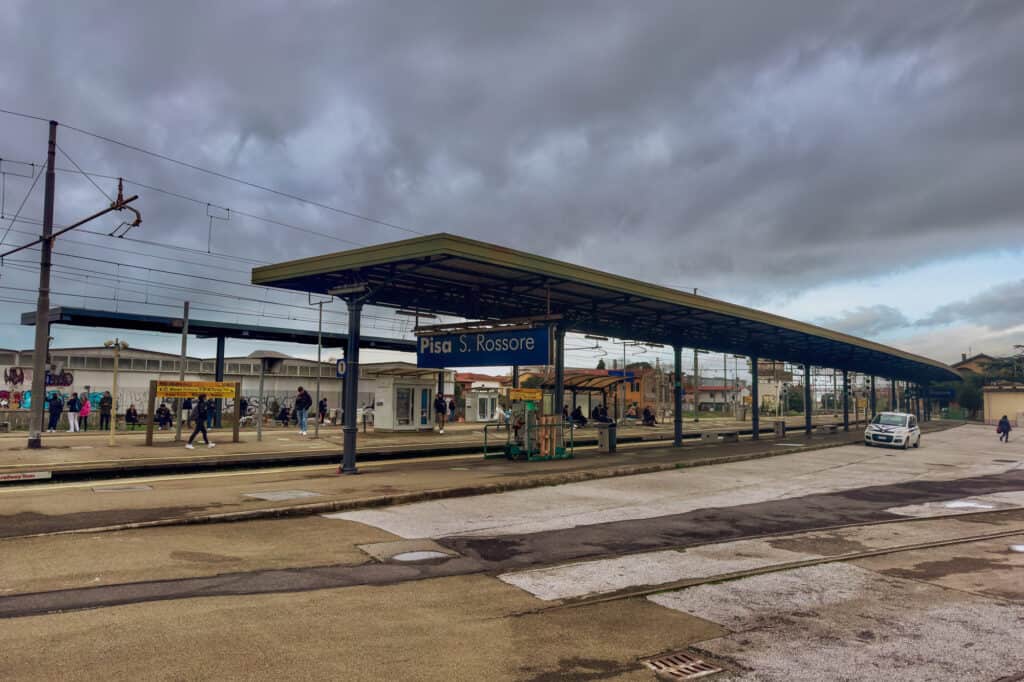
Pisa to Lucca by Train
The train ride to Lucca is only about 30 minutes from Pisa. Trains depart every 30 to 40 minutes.
Lucca to Florence by Train
From Lucca, it’ll take about 90 minutes to get back to Florence by train.
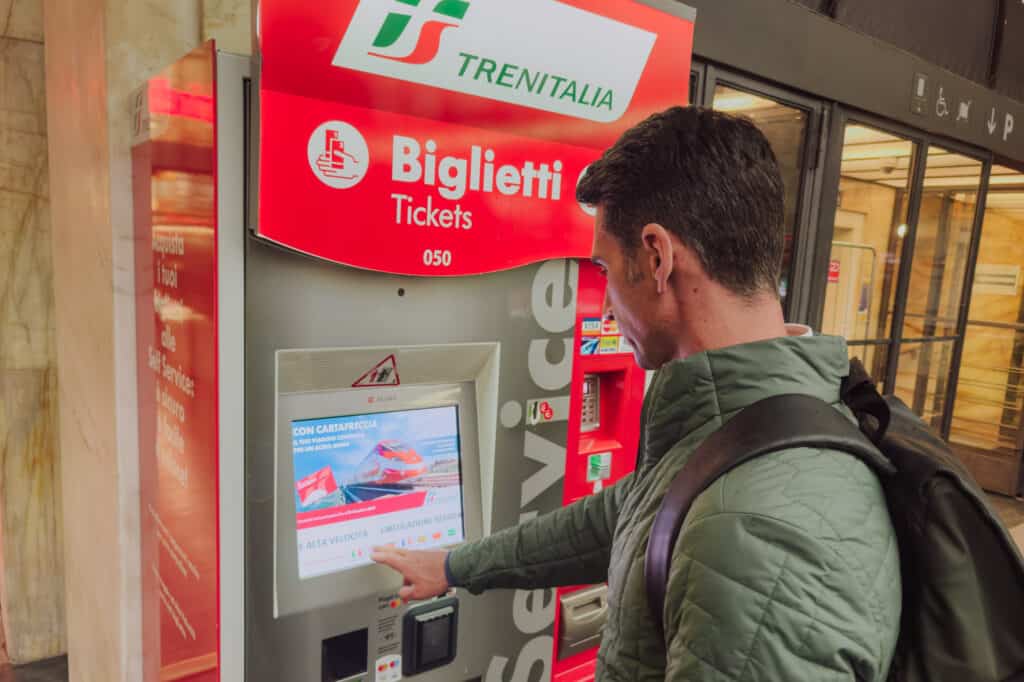
Florence Restaurants
I have four I’ll recommend, but you’ll be able to find delicious Italian food anywhere in the city.
La Giostra
Make reservations here if you want a special meal. It’s a small, intimate setting in a historic building which used to be a garage or warehouse for the carousel!
They’ll likely bring out prosecco or an appetizer on the house.
Don’t skip dessert, no matter how full you are! The “tiramisu su su” is unlike any tiramisu I’ve ever had!
All’Antico Vinaio
Translated to “the ancient winemaker,” this is a viral sensation in Rome and now New York City, too. You’ll often find long lines out the door, but it’s well-organized so the crowd moves quickly.
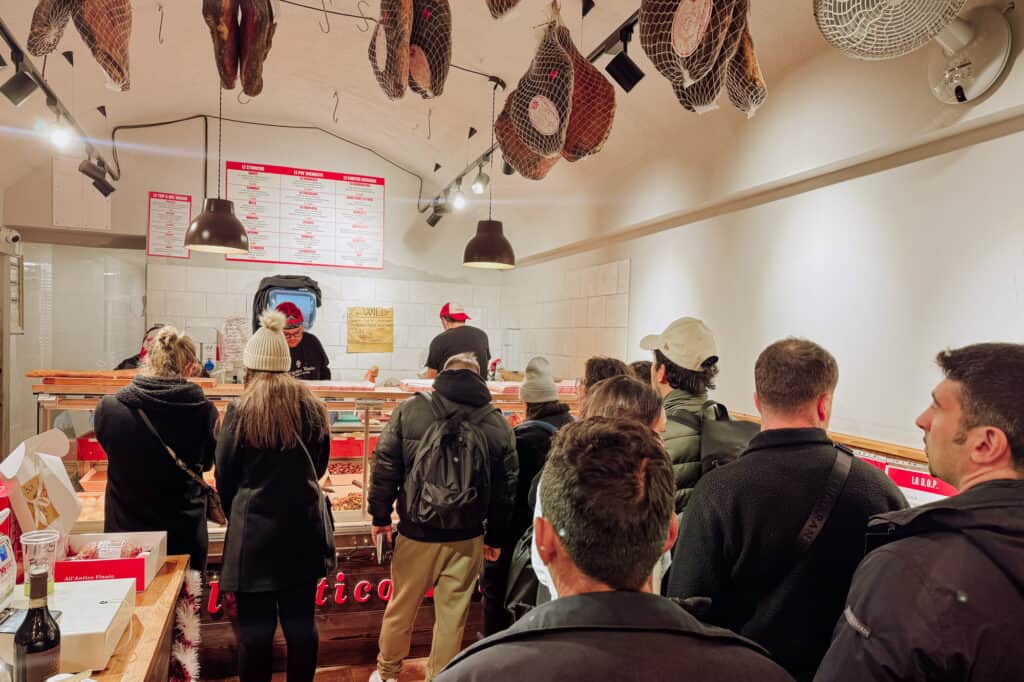
All’Antico Vinaio is a great place for lunch, if you’re looking for a massive sandwich big enough for 3 people to share!
While the sandwiches run $20 in NYC, they’re just 7 to 9 Euros in Florence.
During lunchtime, the line always goes out the door!
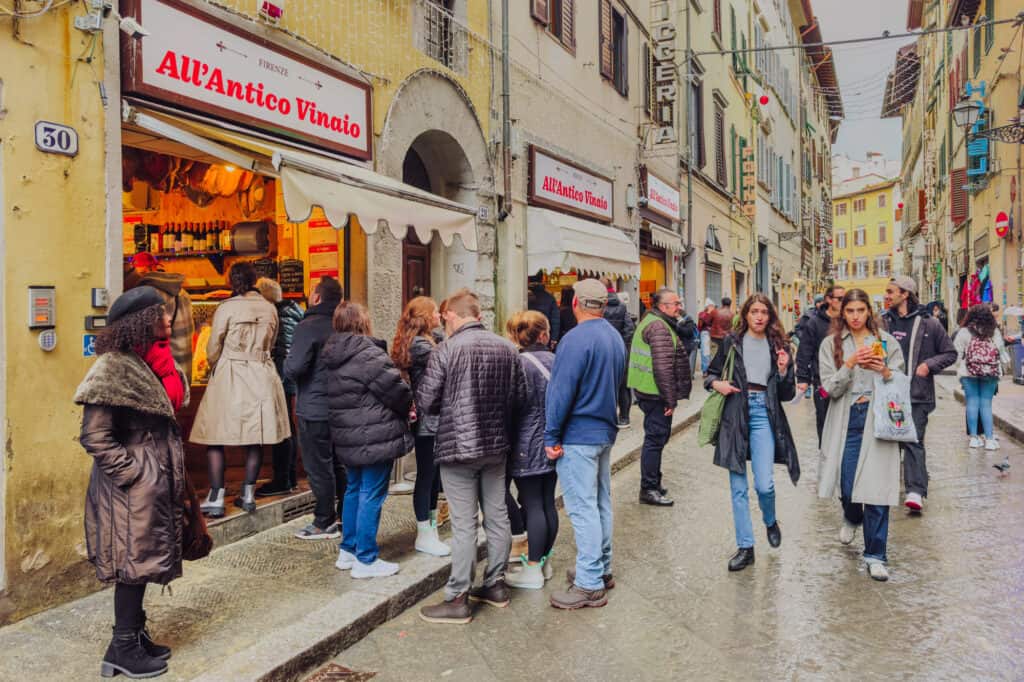
Berberè
For excellent pizza options in Florence, head to Berberè. There are several locations in Italy, but it doesn’t feel like a chain at all.
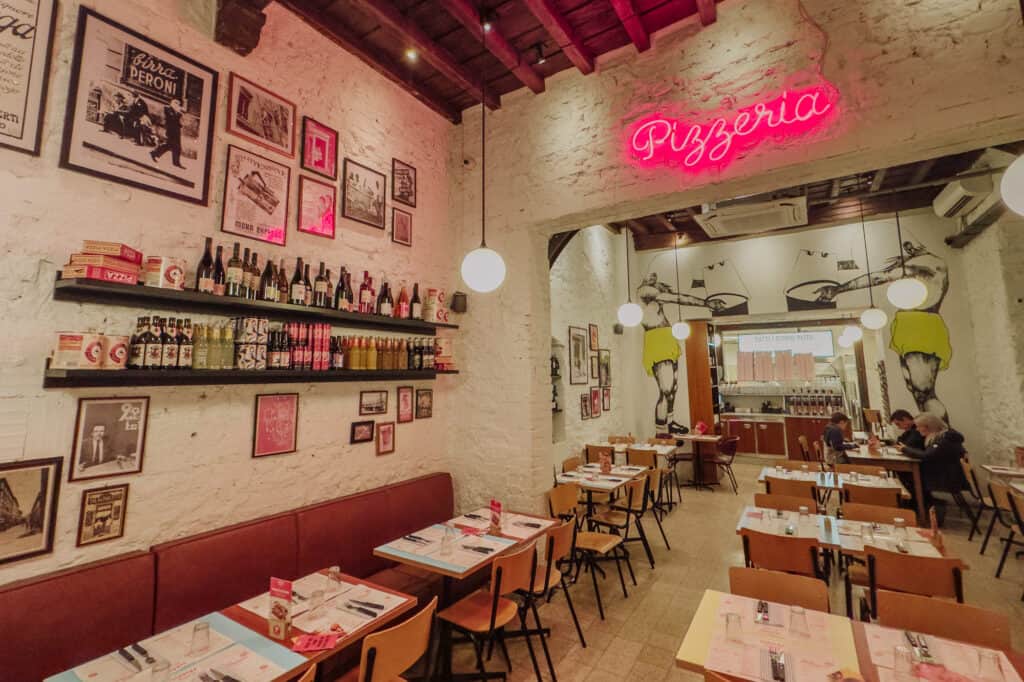
Gino’s
At the end of the Ponte Vecchio (bridge), you’ll find Gino’s, which is famous for tiramisu and other Italian desserts. It will not disappoint.

Favorite trattorias among locals in Florence include:
- 13 Gobbi
- Coquinarius
- Za’ Za
- Osteria Vini e Vecchi Sapori
- Gargani
- Buca Lapi
- Cantinetta Antinori
- Osteria dell’Enoteca
More expensive restaurants which come highly recommended by locals in Florence include:
- Enoteca Pinchiorri
- Cibreo
- Cestello
- Borgo San Jacopo
- Locale
- Ora d’Aria
- ZEB (Zuppa e Bollito)
Getting to Florence
You can certainly fly directly to Florence, but if you plan to spend 3 days there, you’re likely planning to visit other parts of Italy (or Europe in general).
Italy’s excellent train system, Trenitalia, connects the major cities and small towns. The trains make it easy to visit multiple parts of Italy in one trip.
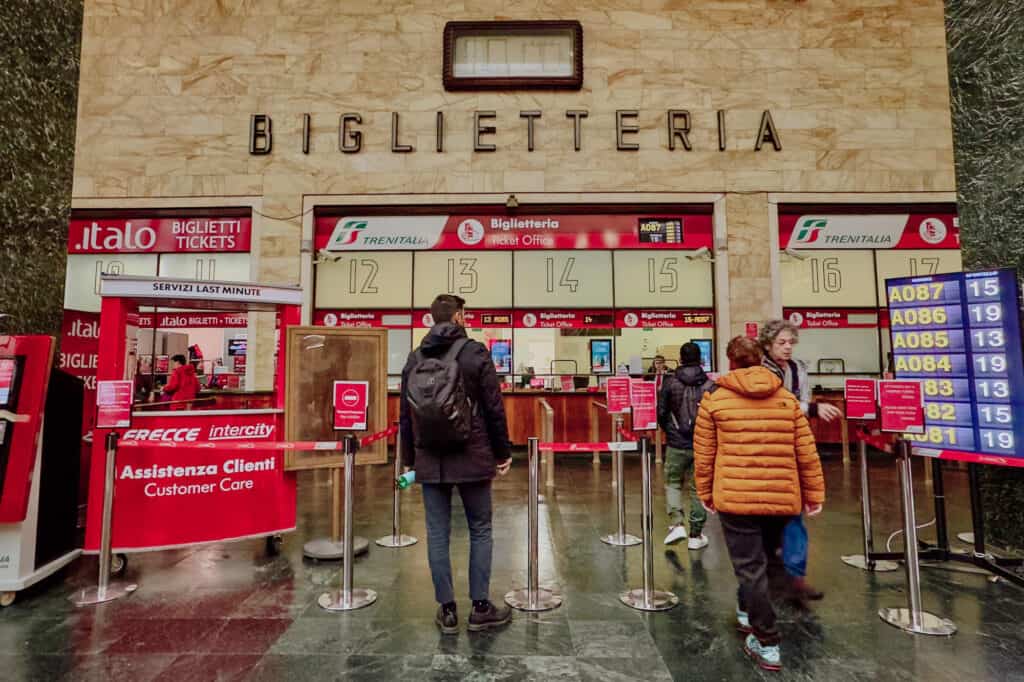
For example, one rail line runs all the way from Venice down through Florence, then Rome, and ultimately Naples. (Keep in mind, the train schedules will read that route as: Venezia, Firenze, Roma, and Napoli).
I’d recommend downloading the Trenitalia App before your trip. While Google Maps also lists train schedules, I found: the Trenitalia App seems to have more options and up-to-date information. It’s free to use, and if you book tickets through the app, it’ll send the QR codes you’ll need to board right to your phone.
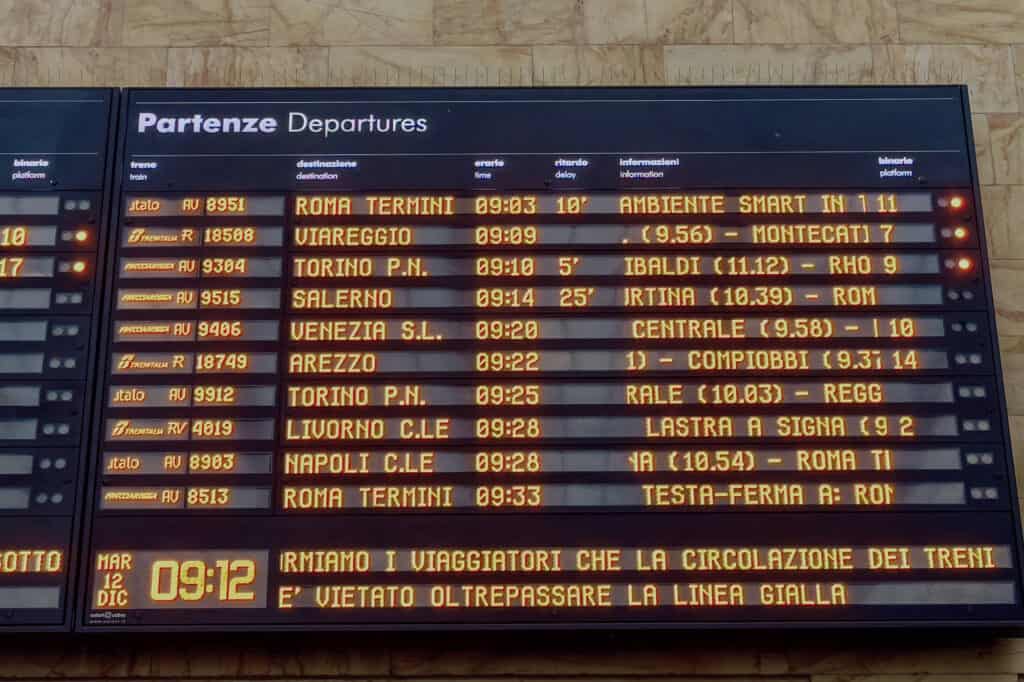
Rome to Florence (Roma to Firenze)
If you’re looking to save money on flights, it’s often less expensive to fly from the USA to Rome or Milan, and then take the train to Florence.
From the massive Roma Termini station in Rome, it’s less than two hours to Florence’s Firenze Santa Maria Novella.
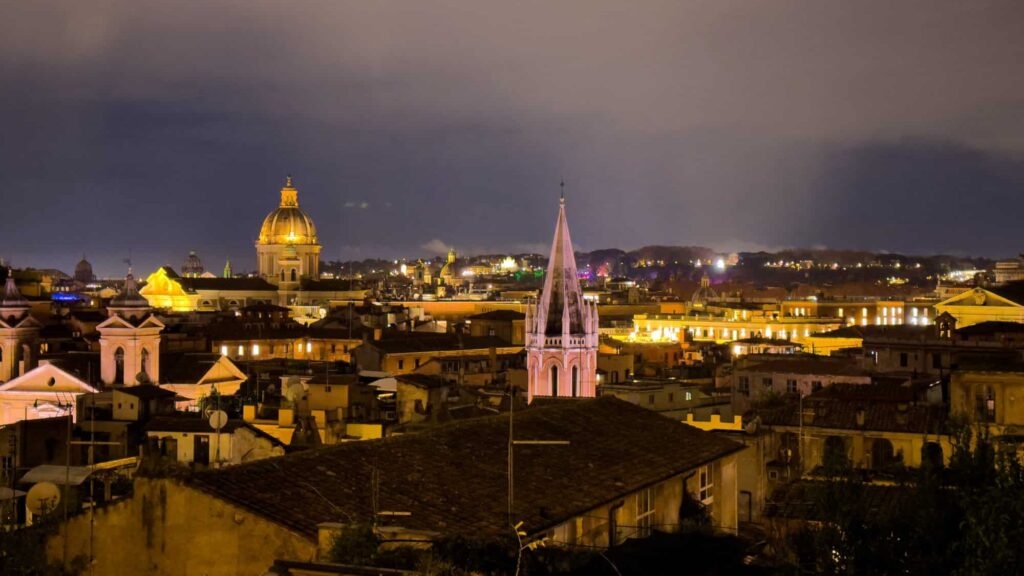
Milan to Florence (Milano to Firenze)
There are several types of trains running between Milan and Florence. The fastest and most common are the high-speed trains:
- Frecciabianca and InterCity: These are slightly slower than Frecciarossa trains but also connect Milan and Florence with a few more intermediate stops.
- Frecciarossa: These are the fastest and most direct trains between Milan and Florence, offering frequent departures and a travel time of around 1.5 to 2 hours.
You can purchase tickets in advance, if you like, online through the Trenitalia or Italo websites.
Naples to Florence (Napoli to Firenze)
Trains depart from Napoli Centrale, the main train station in Naples.
Similar to the Milan to Florence route, there are different types of trains available for the Naples to Florence journey.
- Frecciarossa: These high-speed trains provide a fast and direct connection, typically taking around 2.5 to 3 hours.
Venice to Florence (Venezia to Firenze)
Trains depart from Venezia Santa Lucia, the main train station in Venice.
Similar to the other routes, you have different types of trains available for the Venice to Florence journey:
- Frecciarossa: These high-speed trains offer a direct connection and are the fastest option, taking around 2 hours to 2.5 hours to reach Florence.
- Frecciabianca and InterCity: These trains might take slightly longer due to more intermediate stops but still offer a comfortable journey.
Best Time to Visit Florence
Florence is mild year-round, though slightly cooler than Rome. Once in a while the city will see light snowfall, but even in the winter temperatures remain in the 50s for daytime highs.
The best time to visit Florence really depends on what your plans and goals are.
The grape harvest in late summer and fall is a great time to visit Tuscany.
In December, the city glows with Christmas lights strewn above the shopping boulevards and big displays in plazas.
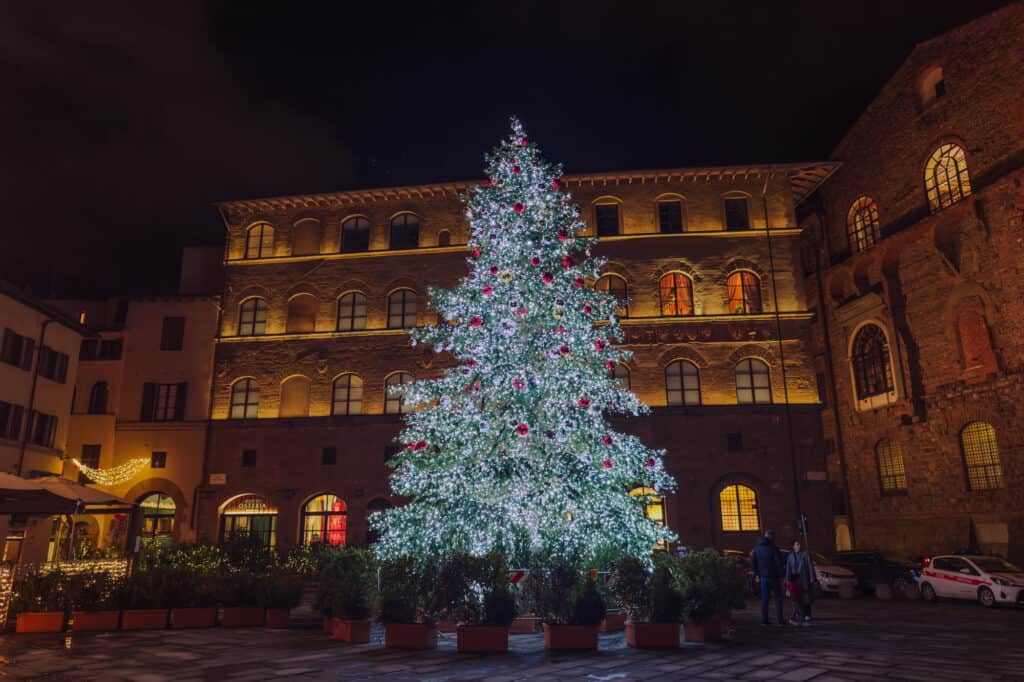
For me, personally, I always recommend “shoulder season” trips to Europe. I know, it’s difficult (or impossible) for people with certain work schedules to vacation in May, September, or October. But the late spring and fall months deliver great weather in Florence, plus much smaller crowds than you’ll find in the summer.
Florence Weather Month by Month
Again, the weather is mild enough in Florence throughout the year that you’ll enjoy a 3-day visit whenever you get the chance!
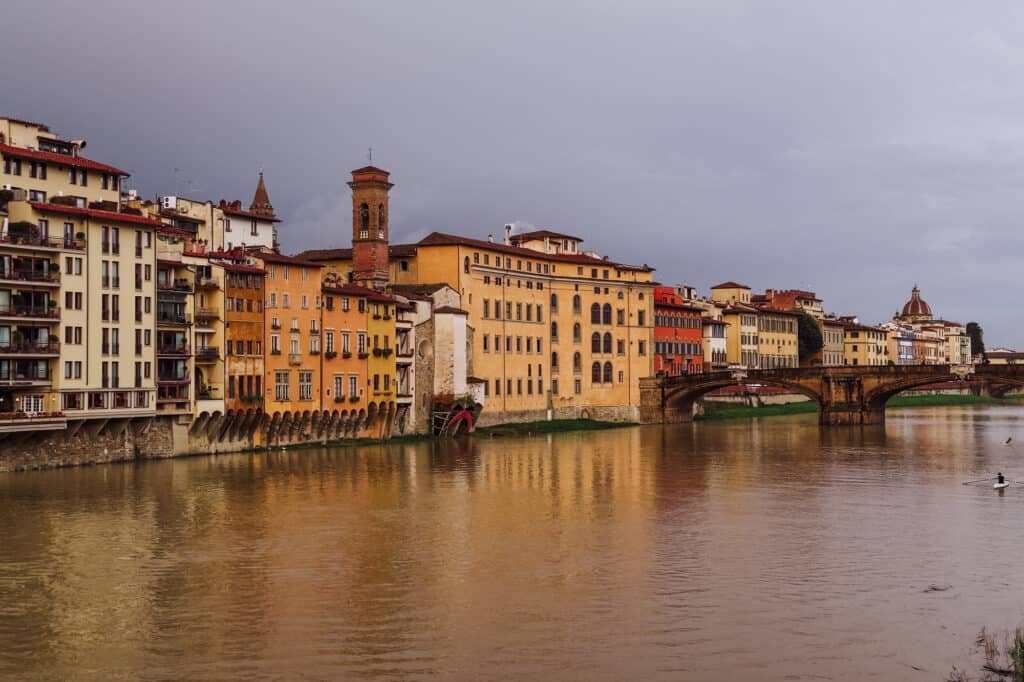
If you have some flexibility, here’s some guidance about temperatures and rainfall, month by month in Florence:
January:
- Average High Temperature: 52°F (11°C)
- Average Low Temperature: 36°F (2°C)
- Average Rainfall: 2.7 inches (68 mm)
- Average Rainy Days: 10 days
February:
- Average High Temperature: 54°F (12°C)
- Average Low Temperature: 37°F (3°C)
- Average Rainfall: 2.4 inches (61 mm)
- Average Rainy Days: 9 days
March:
- Average High Temperature: 59°F (15°C)
- Average Low Temperature: 41°F (5°C)
- Average Rainfall: 2.8 inches (71 mm)
- Average Rainy Days: 10 days
April:
- Average High Temperature: 65°F (18°C)
- Average Low Temperature: 46°F (8°C)
- Average Rainfall: 3.1 inches (79 mm)
- Average Rainy Days: 11 days
May:
- Average High Temperature: 74°F (23°C)
- Average Low Temperature: 53°F (12°C)
- Average Rainfall: 2.6 inches (66 mm)
- Average Rainy Days: 10 days
June:
- Average High Temperature: 81°F (27°C)
- Average Low Temperature: 59°F (15°C)
- Average Rainfall: 2.2 inches (56 mm)
- Average Rainy Days: 8 days
July:
- Average High Temperature: 88°F (31°C)
- Average Low Temperature: 64°F (18°C)
- Average Rainfall: 1.6 inches (41 mm)
- Average Rainy Days: 6 days
August:
- Average High Temperature: 88°F (31°C)
- Average Low Temperature: 64°F (18°C)
- Average Rainfall: 2.6 inches (66 mm)
- Average Rainy Days: 6 days
September:
- Average High Temperature: 80°F (27°C)
- Average Low Temperature: 58°F (14°C)
- Average Rainfall: 3.1 inches (79 mm)
- Average Rainy Days: 7 days
October:
- Average High Temperature: 70°F (21°C)
- Average Low Temperature: 50°F (10°C)
- Average Rainfall: 4.1 inches (104 mm)
- Average Rainy Days: 9 days
November:
- Average High Temperature: 59°F (15°C)
- Average Low Temperature: 42°F (6°C)
- Average Rainfall: 4.0 inches (102 mm)
- Average Rainy Days: 10 days
December:
- Average High Temperature: 53°F (12°C)
- Average Low Temperature: 38°F (3°C)
- Average Rainfall: 3.0 inches (76 mm)
- Average Rainy Days: 10 days
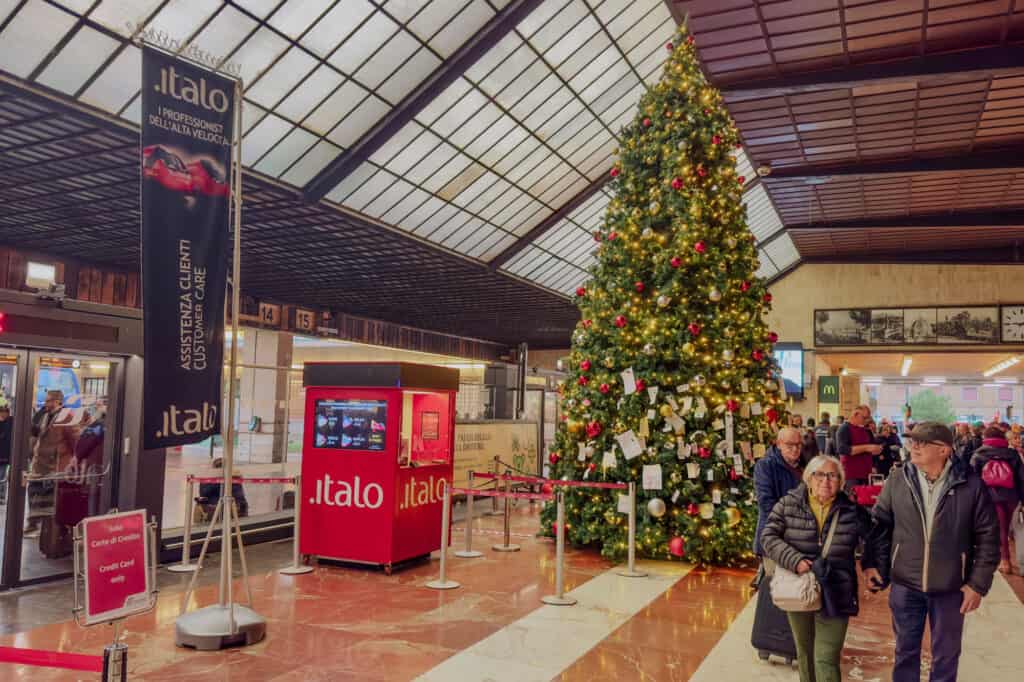
The History of Florence’s Top Attractions
Here’s some brief background information on some of the top sites to see in Florence:
Michaelangelo’s David
Michelangelo’s David is a masterpiece of Renaissance sculpture created between 1501 and 1504. The 17-foot marble statue represents the biblical hero David before his battle with Goliath. Originally placed at the entrance of the Palazzo Vecchio, it was later moved to the Galleria dell’Accademia for preservation.
As I said earlier, if you’d like to see it but don’t want to spend time in the museum, you can see a replica at Piazzale Michelangelo, overlooking the city.
Uffizi Gallery
The Uffizi Gallery was designed by Giorgio Vasari in the 16th century as offices for Florentine magistrates. Over time, the building evolved into a prominent art museum, housing an extensive collection of priceless works, especially from the Renaissance period, bequeathed by the Medici family to the city of Florence.

The Florence Cathedral / Duomo
Construction of the cathedral began in 1296, overseen by architect Arnolfo di Cambio. It was intended to signify Florence’s economic and political power.
One of the cathedral’s most striking features is the iconic dome, designed by Filippo Brunelleschi. The construction of the dome began in 1420 and was a groundbreaking engineering feat, employing innovative techniques without the use of scaffolding. Completed in 1434, the dome remains the largest masonry dome in the world.
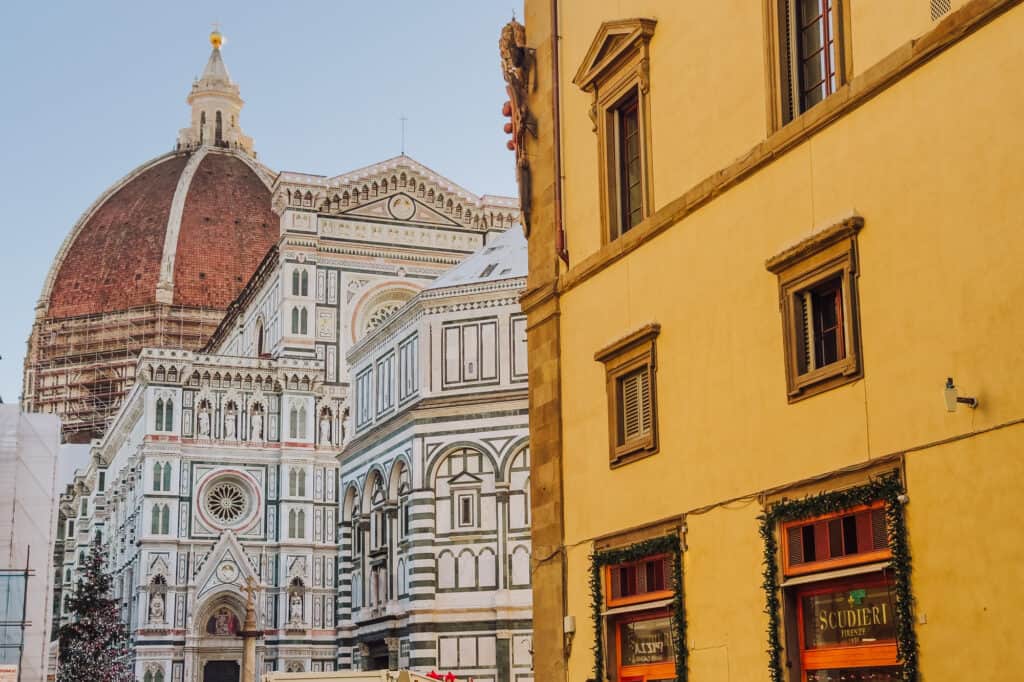
The cathedral’s exterior is an intricate marble façade, adorned with sculptures and decorative elements.
Throughout its history, the cathedral has undergone numerous restorations to preserve its structural integrity and artistic elements. Modern efforts continue to maintain and conserve this iconic symbol of Florentine history and culture.
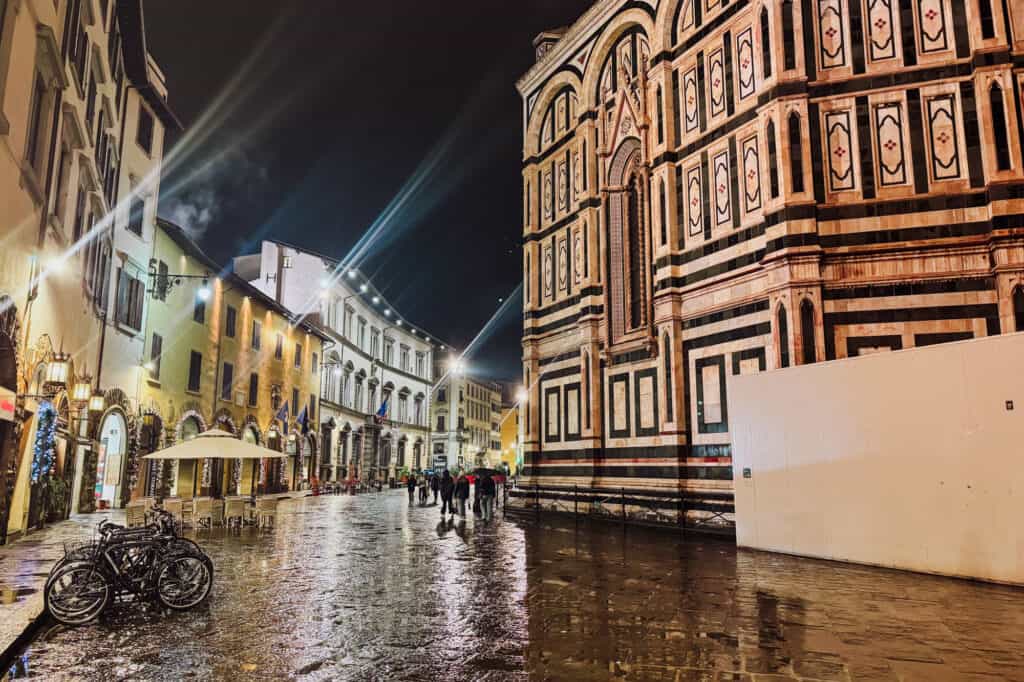
Accademia Gallery
Founded in the 18th century, the Accademia Gallery initially served as an art school. It’s most renowned for housing Michelangelo’s David, attracting visitors worldwide to admire this iconic sculpture. The gallery expanded its collection over time, displaying other notable works by artists such as Botticelli and Giambologna.
Palazzo Vecchio
Palazzo Vecchio, originally known as Palazzo della Signoria, has been the seat of Florentine government for centuries. This fortress-like palace dates back to the 14th century and bears the marks of various architects.
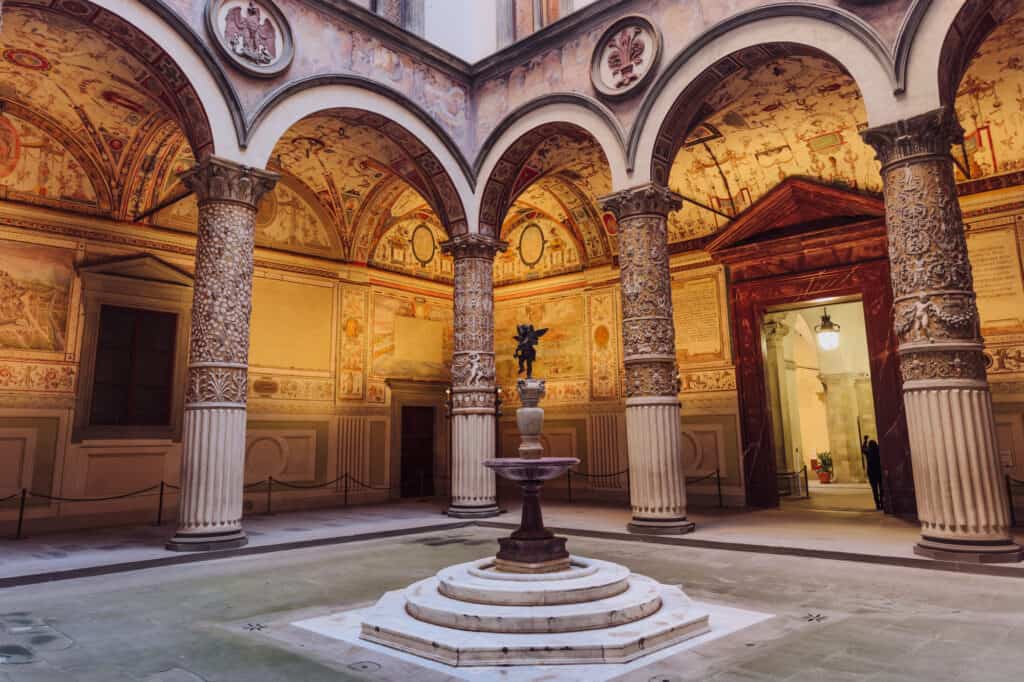
Its impressive halls and chambers house significant artworks and serve as a testament to the city’s history.
Even the walls and ceilings in the entrance are stunning.
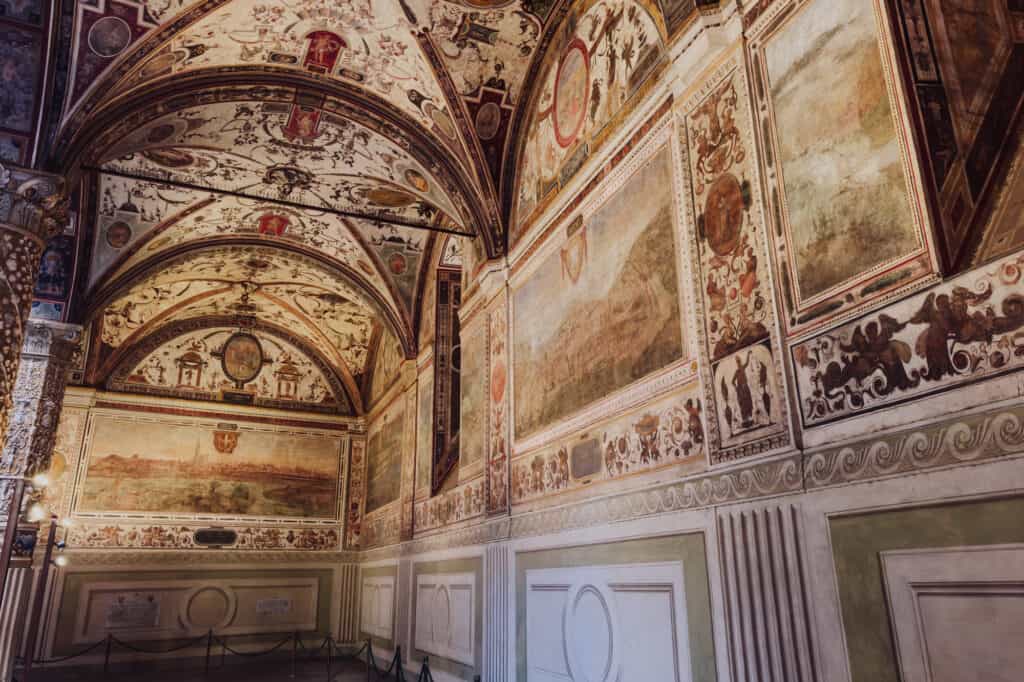
Ponte Vecchio Bridge
The Ponte Vecchio bridge was originally constructed during Roman times, and has undergone several reconstructions due to floods on the Arno River.
The current structure, dating back to the 14th century, is distinct for its three arches and the unusual feature of shops built along the bridge itself. Initially hosting butchers and other merchants. The shops were eventually replaced by goldsmiths and jewelers during the 16th century on the orders of the Medici family, who sought to elevate the bridge’s aesthetic.
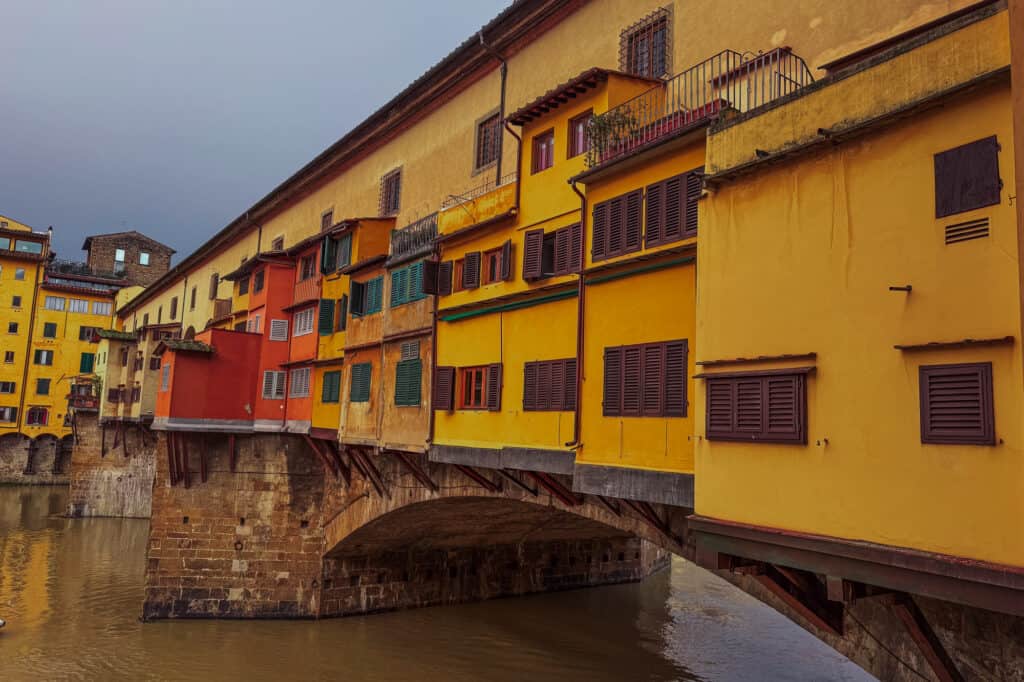
You’ll notice: the bridge has a second floor above. Known as the Vasari Corridor, it was commissioned by the Medici family to connect the Palazzo Vecchio to the Palazzo Pitti, providing a private route for the ruling family.
These days, the businesses on the bridge sell gold and jewelry.
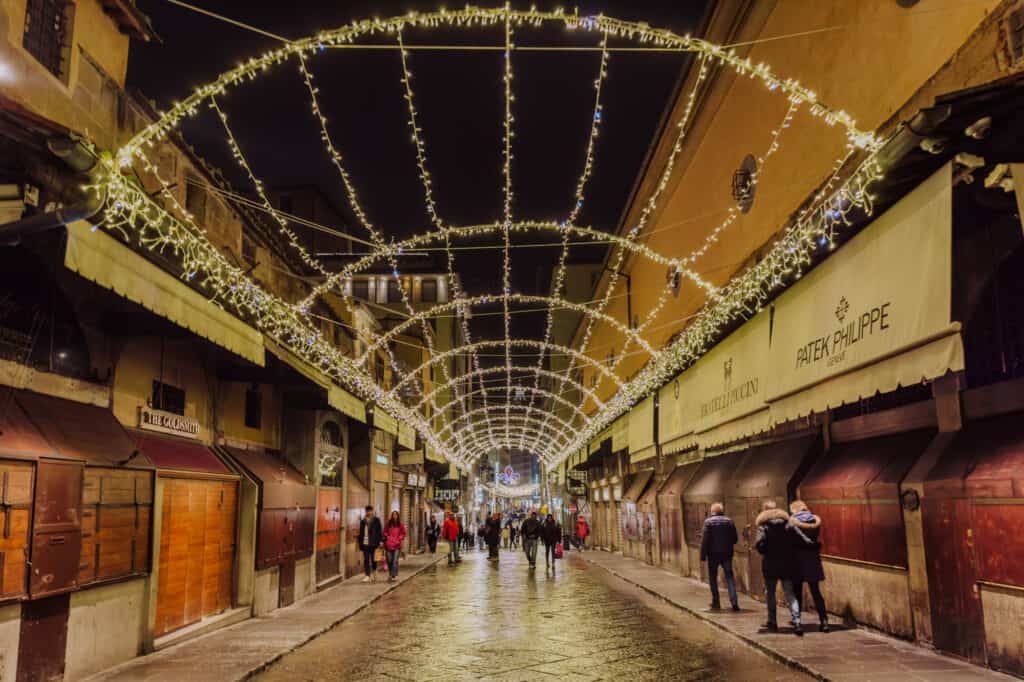
Despite the destruction of other bridges during World War II, the Ponte Vecchio remained unharmed, preserving its historic and architectural significance.
Santa Croce
Founded by the Franciscan Order in the 13th century, Santa Croce was built on the site where St. Francis of Assisi reportedly preached during his visit to Florence. Construction began in 1294 and continued for more than a century.

Santa Croce holds the tombs and memorials of numerous influential figures from Italian history and culture. Notable burials include Michelangelo Buonarroti, Galileo Galilei, Niccolò Machiavelli, and Dante Alighieri (though Dante’s actual burial place is debated).
The basilica houses significant artworks, including Giotto’s frescoes depicting the life of St. Francis, Cimabue’s Crucifix, and Donatello’s Annunciation.
The plaza in front of the cathedral hosts Florence’s largest Christmas market each December.
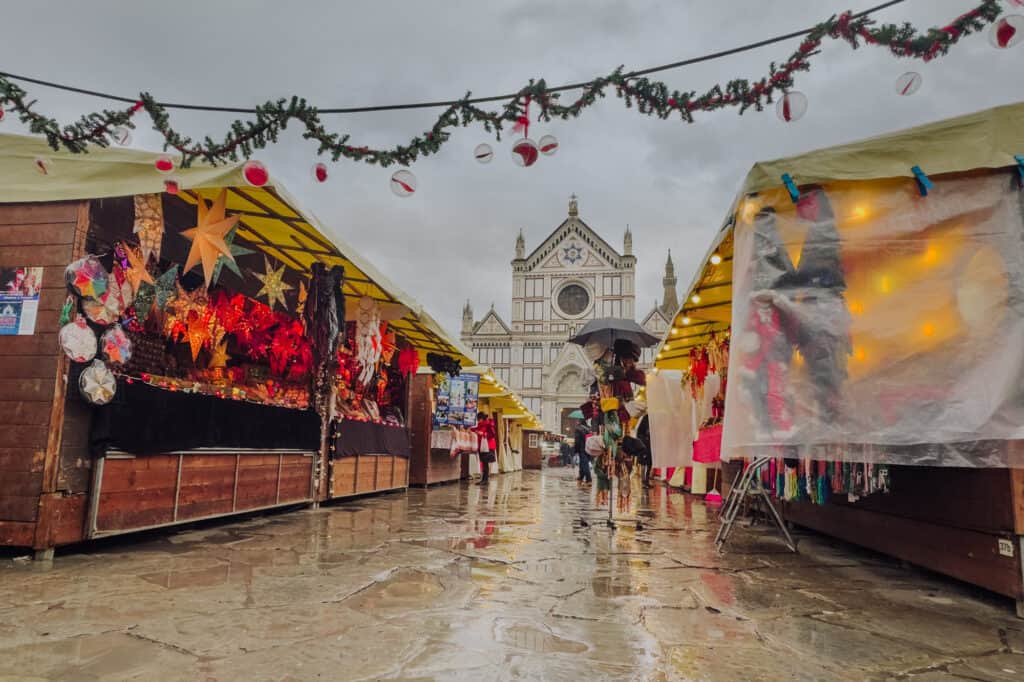
Boboli Gardens
The Boboli Gardens, located behind the Pitti Palace, were designed in the mid-16th century by Niccolò Pericoli, known as Tribolo. Commissioned by the Medici family, the gardens served as a private space for the ruling family to relax and entertain guests.
The gardens cover around 111 acres, covered in terraces, pathways, sculptures, fountains, and a variety of plant species. Notable sculptures include works by Giambologna, such as the “Bathing Venus” and “Hercules and the Centaur.” The gardens also showcase elaborate fountains, including the Fountain of Neptune and the Fountain of Ocean.
Today, the gardens are open to the public.
The Medici Family
Since the Medici Family is connected to several of Florence’s famous sites, here’s a brief history of their prominence and influence.
Rise to Power: The Medici family emerged as wealthy bankers and merchants in the 15th century, effectively becoming the de facto rulers of Florence through their financial influence.
Patrons of the Arts: The Medici were renowned patrons of the arts, who supported and commissioned works by Michelangelo, Botticelli, Leonardo da Vinci, and Raphael.
Political Influence: The Medici family held key positions in the Florentine government, with family members serving as rulers, diplomats, and popes, including Lorenzo the Magnificent and Pope Leo X.
Palaces: The Medicis commissioned architectural projects, including the construction of palaces such as Palazzo Medici Riccardi and Palazzo Pitti, as well as the Vasari Corridor, connecting the Palazzo Vecchio to the Palazzo Pitti through the Ponte Vecchio.
Even as the family’s direct rule in Florence came to an end in the 18th century, their legacy as patrons of the arts, cultural influencers, and shapers of Italian history endures to this day.
The tower at the Palazzo Vecchio can be seen from most parts of the city.
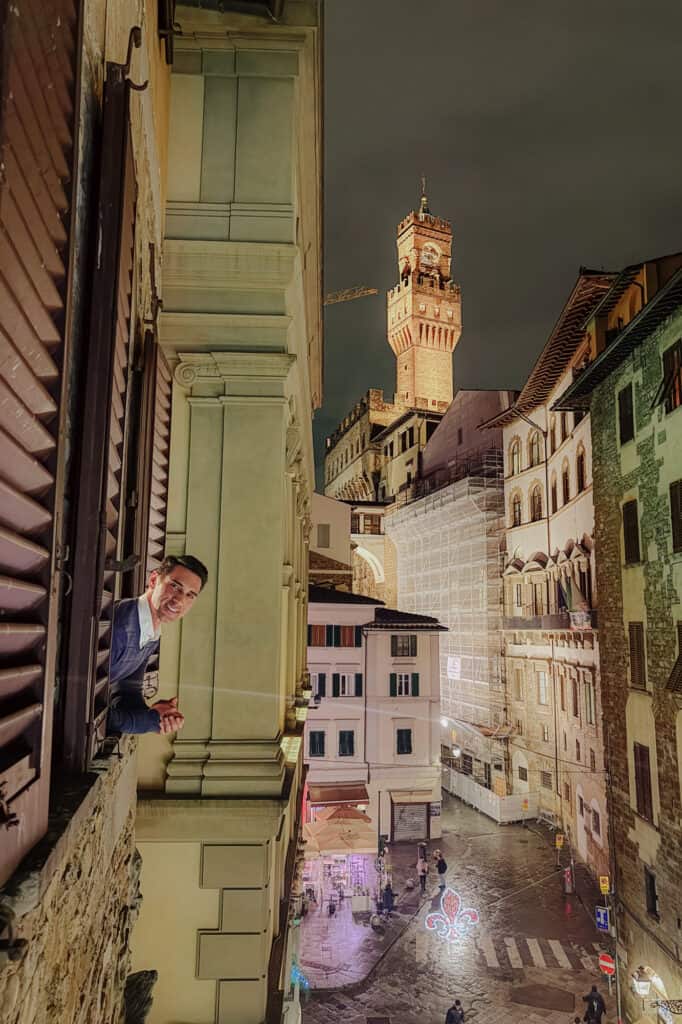
10 Off-the-Beaten-Path Sites in Florence
Here are a few off-the-beaten-path places to check out in Florence, if you’ve already seen the make sites:
- San Miniato al Monte: This church sits atop a hill overlooking Florence, offering breathtaking views of the city, along with beautiful frescoes and intricate mosaics.
- Bardini Gardens: Often overshadowed by the Boboli Gardens, the Bardini Gardens offer a quieter experience with panoramic views.
- Palazzo Davanzati: A lesser-known museum, this medieval palace provides an authentic glimpse into Florence’s history, showcasing the daily life of the city’s noble families during the Renaissance.
- Vasari Corridor (Corridoio Vasariano): While not entirely off-the-beaten-path, this enclosed passageway connecting Palazzo Vecchio to Palazzo Pitti is a unique experience, offering views over the Ponte Vecchio and the Arno River.
- Museum of San Marco: This former monastery houses remarkable frescoes by Fra Angelico, away from the crowds.
- Officina Profumo-Farmaceutica di Santa Maria Novella: One of the oldest pharmacies in the world, dating back to the 13th century, where visitors can explore historical medicinal products and perfumes.
- Florence’s Street Art: Wander through the Oltrarno district or other less touristy neighborhoods to discover vibrant street art and murals adorning walls and alleys.
- Stibbert Museum: A unique collection of armor, weapons, costumes, and art from various cultures housed in a villa that once belonged to an English collector.
- Le Cascine Park: This expansive park along the Arno River offers an escape from the city center, perfect for picnics, cycling, or walks.
- Orsanmichele Church and Museum: This former granary transformed into a church showcases impressive sculptures on its exterior and houses artistic masterpieces inside.
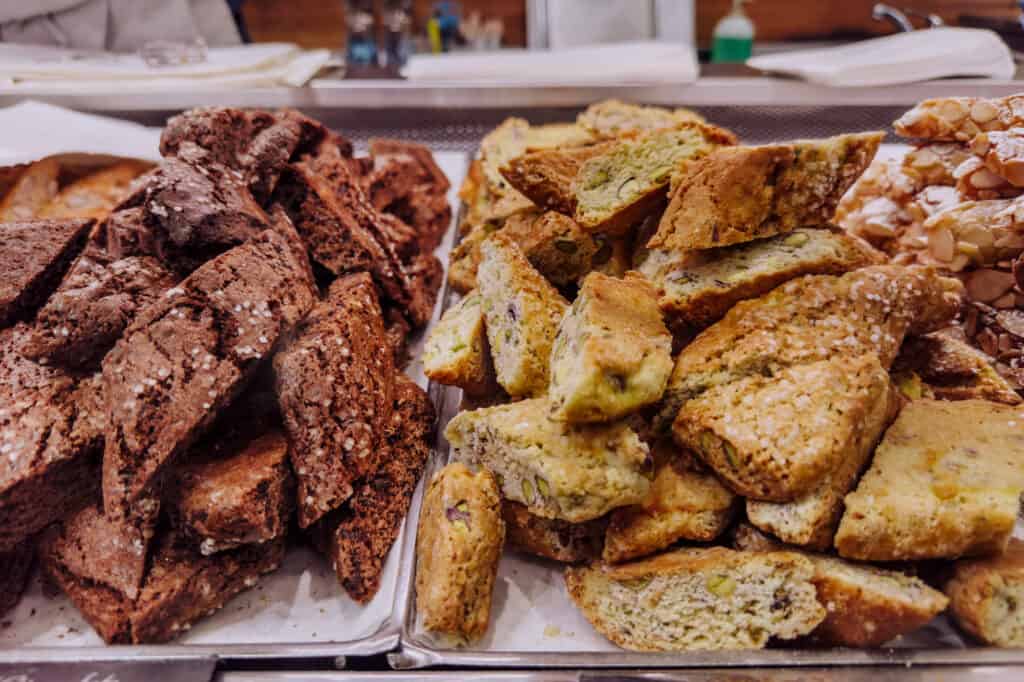
FAQs About Spending 3 Days in Florence, Italy
Let’s tackle a few more frequently-asked-questions about spending 3 days in Florence, Italy. Many of these have already been answered above.
Is Florence a walkable city?
Absolutely. You can arrive at the train station, and take a cab if you have a lot of luggage, but otherwise you’ll be fine on your feet!
What should I pack for 3 days in Florence?
Of course, it depends on the season. In the fall, winter, and spring, pack layers which you can shed as the sun warms the day.
Regardless of the season, I’d pack:
- an umbrella
- SPF
- an electrical converter
- comfortable walking shoes (that won’t slip on the stone streets)

Should I stay in a hotel or rent an Airbnb in Florence?
Florence has many great apartments to rent in historic buildings.
If you’re traveling with friends or family, I’d definitely recommend renting an apartment with multiple bedrooms. It’ll give everyone space and privacy, plus a gathering point to hang out. It’s more economical than renting multiple hotel rooms, too!
What are other good day trip destinations from Florence or Rome?
In addition to San Gimignano, Cinque Terre, Lucca, Siena, Pisa and other spots from Florence, I’d recommend day trips to the gorgeous hilltop towns of Orvieto and Assisi (pictured below). They’re easy to get to from Rome!
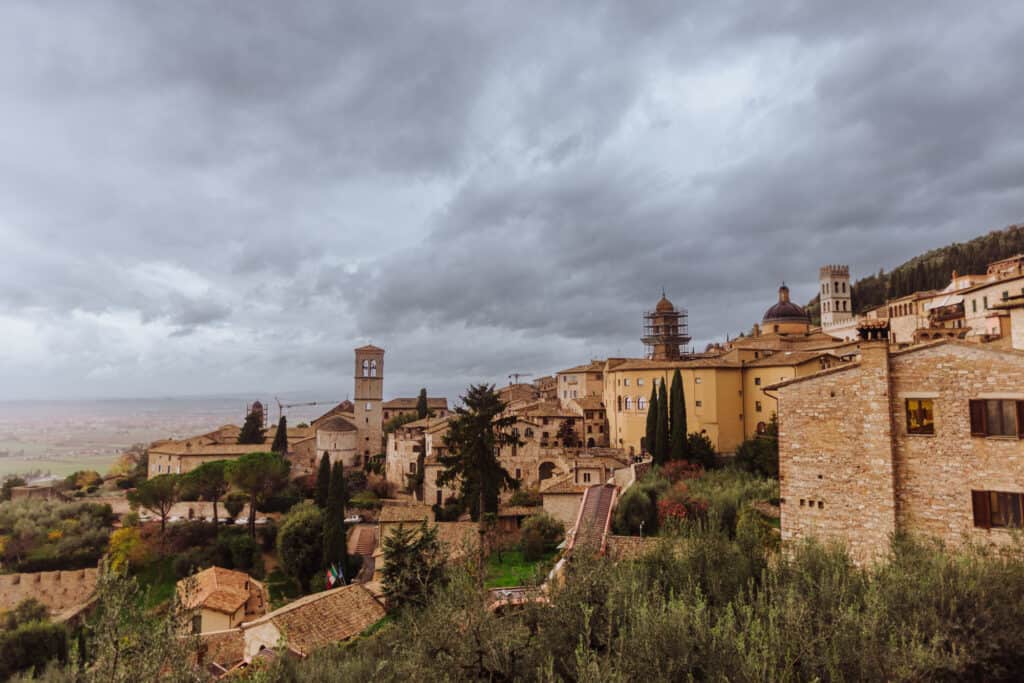
Wrap: Is 3 Days Enough in Florence?
For me, 3 days is never enough in most cities, and that’s certainly true in Florence.
I envy all of the college students who choose to study abroad here, and get to really know the streets and the culture.
For the rest of us (with jobs and other responsibilities in life) three days can provide a wonderful introduction to Florence and the surrounding cities in Tuscany.
It’s worth prioritizing your interests and choosing the attractions you connect most with. If it’s shopping, great! If it’s art, great!
Whatever your priorities and whichever path you choose over 3 days in Florence, I promise: every meal will be memorable!
